Application of TRIZ Innovative System Method in Rapid Assembly of Folding Chairs
Abstract
1. Introduction
2. Discussion of the Literature
2.1. Literature Review on Seat Design and Related Materials
2.2. Repeatability Causes Damage
2.3. TRIZ Method Literature Discussion
2.4. The Human Factors Engineering Literature
2.5. The General Design Literature Discussion
2.6. IPA
3. Design Research
3.1. Design Reference Goals for Folding Chairs
3.2. Exploring the Innovative Design of the Folding Chair
3.2.1. The TRIZ Method Is Introduced into the Innovative Design of the Folding Chair for Rapid Unfolding
3.2.2. Innovative Design for the Rapid Development of Human-Introduced Folding Chairs
- Repeated action micro-injury: For repetitive movements, it is found that the operation of the general folding chair needs to simplify the extra action to reduce the movement of excessive parts of the body. In this study, the innovative design operation of the folding chair is quickly expanded into a folding chair. One hand at the back is used to operate the folding chair to remove the repetitive movement of the waist and reduce the repeated movement of the hand.
- Hazard of operation: When a large number of folding chairs are arranged in a large number, it may be dangerous to handle the hand and flash to the waist for the sake of speed. In this study, the innovative design of the folding chair is rapidly developed, in order to solve the above problems, with one hand, the chair foot and the seat cushion are attached to the natural gravity downwards, so that the hand does not touch the folding range of the folding chair, thereby improving the safety of the folding chair. See Figure 8.
- Arrange time-consuming problems: Generally, when the folding chair is opened, it needs to be bent over and pulled out to achieve the function of unfolding the folding chair, but the opening time is not simplified. This study is designed to open the chair and the chair cushion with one hand. The fitting is naturally carried out by gravity and the movement can be quickly developed to enhance the convenience of the folding chair. See Figure 9.
3.2.3. The Universal Design Method Introduces the Innovative Design of the Folding Chair
- Fair use: Using the principle of fair use of the seven principles of universal design, use one hand to pull the chair foot with a pull ring and let the chair foot and the seat cushion expand naturally under gravity to achieve speed development. Functionally, the size of the pull ring is suitable for various users and the position of the pull ring is designed to be the height that the user can use when standing backwards. The innovative design of the folding chair is in accordance with the fair use principle.
- Simple and intuitive use: Using the simple and intuitive use principle of the seven principles of universal design, the design position of the pull ring is modified into an asymmetrical position, so that the user can clearly see the position of the pull ring and quickly operate the folding chair quickly. The innovative design that allows the folding chair to expand quickly is simple and intuitive.
- Labor-saving: Using the labor-saving principle of the seven principles of universal design, improving the material of the chair foot and designing the shape of the hole to reduce the weight of the chair foot, allowing the user to open the folding chair more flexibly and quickly, so that the folding chair can be quickly deployed. Innovative design meets the principle of labor saving.
- When using size and space: In the seven principles of universal design are the principles of size and space, improving the distance and size after unfolding, ensuring the use of space during the exhibition are more convenient, and ensuring the folding chair is an innovative design. Compliance is the principle of size and space usage.
3.3. Exploring the Innovative Design of Folding Chairs for Quick Folding
3.3.1. Innovative Design of TRIZ-Imported Folding Chair for Quick Folding
3.3.2. Innovative Design of Human Body Due to the Introduction of Folding Chairs for Rapid Folding
- Repeated action micro-injury: For repetitive movements, it is found that the operation of the general folding chair needs to simplify the extra action to reduce the movement of excessive parts of the body. In this study, the innovative design operation action of the folding chair is quickly folded into a person standing in the fold. Use the foot to step on the back of the chair to operate the folding chair to remove the re-action of the waist and the hand, causing the folding chair to be safer.
- Standing problem after folding: Generally, the folding chair cannot stand when the folding is folded, causing the chair to fall to the ground. In the case of a large number of folding, most of the time is saved on the ground to save the time, causing the damage rate of the chair to increase. Taking it away can cause damage to the body and waste time. To solve the above problems, the bicycle is designed to be operated by using a foot pedal to operate the folding chair and a supporting foot is added to the rear leg. When the chair is folded, the chair can stand on its own.
- Arrange time-consuming problems: When the chair is arranged in the exhibition, the exhibitors will need to quickly fold the folding chair when the exhibition is closed. The folding operation of the folding chair needs to be bent and folded, so that the folding chair operation is not streamlined when the arrangement is large. This study was designed to use the man to step on the pedal after the folding chair to achieve a quick folding.
3.3.3. Universal Design Introduces the Innovative Design of Folding Chair for Quick Folding
- Fair use: Using the principle of fair use of the seven principles of universal design, the folding chair can be used to fold the back of the folding chair and the position of the pedal can be improved, so that the sole of the foot can be gently tilted and stepped on, so that the folding chair can be easily folded. A variety of operators can easily fold, so that the innovative design of the folding chair can be quickly developed in accordance with the principle of fair use.
- Simple and intuitive use: Using the simple and intuitive principle of the seven principles of universal design, the tread bar is placed behind the folding chair, and the connecting line is fastened to the seat cushion so that the operator can clearly see that the folding chair is rapidly expanding from behind the folding chair. The innovative design and operation, combined with the simplicity of operation, cause the folding chair’s innovative design to be fast and easy to use. See Figure 13.
- Labor-saving: Using the labor-saving principle of the seven principles of universal design, the chair cushion, and the chair foot material are changed to lighter materials and the holes and shapes are designed to reduce the weight of the folding chair, so that the user can operate the folding chair to be more labor-saving. The innovative design that allows the folding chair to unfold quickly is in line with the principle of labor saving. See Figure 14.
- When using size and space: The seven principles of universal design involve the principles of size and space. The folding thickness after folding is improved and the folding chair can be folded and placed in the room for more use. The fast expanding innovative design meets the principles of size and space, as shown in Figure 9.
3.4. Innovative Design of the Rapid Handling and Deployment of Folding Chairs
3.4.1. TRIZ Introduces Innovative Design for Rapid Handling and Deployment
3.4.2. Innovative Design for Introducing Rapid Handling and Deployment Functions for Human Engineering Design
- It is impossible to carry more problems: The folding chair cannot be transported more than one time and it needs to be transported back and forth many times, which wastes time and labor costs. In this study, the innovative design of the folding chair quick handling and deployment function uses the folding chair to extend back. The folding chair is joined to the back of the folding chair so that two people can carry from five to eight chairs at the same time, so that the folding chair can be quickly transported.
- Time-consuming problems in deployment: Generally, the folding chairs need to be aligned one by one during the exhibition. The deployment process is very time-consuming and cannot be quickly deployed. The innovative design of the folding chair for rapid handling and deployment functions uses the folding chair to extend back and fold. The chair is engaged with the back of the folding chair so that the jointed chairs are aligned and transported directly to the positioning without any alignment.
3.4.3. Universal Design Introduces Innovative Design for Rapid Handling and Deployment
- Fair use: Using the fair use principle of the seven principles of universal design, the folding is increased by the buckle of the seat back, so that the back and the back of the chair can be automatically aligned and fastened by the inclination without careful alignment. The mouth is suitable for a variety of operators to operate, so that the innovative design of the rapid handling and deployment functions is in line with the principle of fair use. See Figure 18.
- Simple and intuitive use: Using the simple and intuitive principle of the seven principles of universal design, the shape of the joint extending from the back of the chair is designed to have a hole on the side of the interface without a hole and the joint head is designed to have a hole so that the operator can immediately distinguish between the joint and the joint head, allowing the operator to use the innovative design of quick handling and deployment functions easily and intuitively. See Figure 15.
- Labor-saving: Using the labor-saving principle of the seven principles of universal design, the fasteners that combine the back of the chair and the seat back are quickly fastened by the weak spring. The seat back can be separated from the back of the chair by gently pressing, so that the back of the chair is connected with separate operation points are more labor-saving.
- When size and space are used: The joints and joint heads extending on both sides of the back of the chair are sized to match the distance between the chair and the chair, so that the innovative design using the quick handling and setting function is at the distance of the chair. See Figure 19.
3.5. Preliminary Novelty Assessment Method
- “Does this feature exist in any other product?” The answer is “Yes”. Therefore, the product is not a “very new” product, see Figure 20.
- “Is the structure the same as other products?” The answer is no, i.e., the structure of the Quick Display Folding Chair is different from that of a normal folding chair. Therefore, the product has some novelty, see Figure 20.
- Next, we compare the SAPPhIRE model of the Rapid Display Folding Chair with the general folding chair. It is found that the fast-folding chair in the physical phenomenon and the general folding chair have the principle of support, but the fast-folding chair also has the principle of merging multiple chairs. Additionally, the fast-folding chair state changes the way it opens and its organ adds a new pull ring and pedal lever. Therefore, the speed folding chair is a “high novelty” product, see Figure 20.
3.6. IPA
4. Product Design
4.1. Folding Chair Overall Structure with Quick Assembly and Deployment Function
4.2. Folding Chair Design
4.3. Folding Chair Fast-Folding Function Design
4.4. Folding Chair Design for Rapid Handling and Deployment
5. Conclusions
5.1. Folding Chair Quick Release Function
5.2. Folding Chair Quick Folding Function
5.3. Folding Chair Fast Handling and Deployment Function
6. Discussion
- Folding chair fast-unfolding function: Although the folding chair can be quickly un-folded to achieve rapid deployment function, in the operation, one needs to pay attention to whether there are people in front, otherwise it will hit people standing in front and lead to injury. Additionally, one needs to pay attention to whether there is something near the unfolding space; otherwise, it will cause damage to objects and or the folding chair legs. This folding chair’s fast-unfolding function cannot be operated in a small space. Although the safety of single person operation is solved through the systematic innovation method, it also causes the limitation of space use.
- Folding chair fast-folding function: in the fast-folding function, one only needs to use the foot pedal to fold it up but should pay attention to keeping one’s hands outside the range of the closing parts, otherwise it will lead to injury. When stepping, one only needs to gently step on the bar, and not vigorously. When the force is too great, it may cause the folding chair to become destabilized when unfolded and might cause breakage. This folding chair’s fast-folding function uses an elastic belt to achieve the effect of folding, thus the life expectancy is shorter compared to that of conventional folding chairs.
- Folding chair fast transport and exhibition function: the fast transport and exhibition function can increase the speed of transport, but there are certain restrictions on the number of joined chairs and the overall combined weight of the chairs. No more than 10 chairs should be moved, otherwise transportation may be hindered and damage may occur to joints, as well as incurring safety issues for the fast-unfolding function and fast-folding function when deploying exhibition seating. Although the folding chairs can be linked together through the folding chair fast transport and exhibition function, there is a limitation on the number of chairs that can be linked together.
7. Expected Impact
8. Patents
Author Contributions
Funding
Institutional Review Board Statement
Informed Consent Statement
Data Availability Statement
Acknowledgments
Conflicts of Interest
References
- Cheng, H.Y.; Ng, P.K.; Nathan, R.J.; Saptari, A.; Ng, Y.J.; Yeow, J.A.; Ng, K.Y. The Conceptualisation and Development of a Space-Saving Multipurpose Table for Enhanced Ergonomic Performance. Inventions 2021, 6, 67. [Google Scholar] [CrossRef]
- Cai, J. Health Promotion and Ergonomic Notes. 2017. Available online: http://ergopt.blogspot.com/2017/07/WMD.html (accessed on 22 June 2022).
- Huang, B. Reference Guidelines for the Identification of Occupational Lumbar Disc Herniation; Department of Occupational Safety and Health, Ministry of Labor: Beijing, China, 2018; pp. 1–31. Available online: https://reurl.cc/Z1jmEV (accessed on 22 June 2022).
- Social and Family Affairs Administration, MOHW. Age-Specific Data on Cause of Death in Children from 2016 to 2020. 2021. Available online: https://www.sfaa.gov.tw/SFAA/Pages/Detail.aspx?nodeid=453&pid=7717 (accessed on 22 June 2022).
- Xu, N. Student’s Finger is Pinched by Folding Chair, Police and Firefighters Help Out. 2012. Available online: https://reurl.cc/k1Em7q (accessed on 22 June 2022).
- Xu, C.M.; Hsu, L.H. In Exchange for the Death of a Girl! Bureau of Standards and Inspection: Folding Chairs Are Listed as Commodities Subject to Inspection within Six Months. Apple Daily. 2019. Available online: https://reurl.cc/KXr7vj (accessed on 22 June 2022).
- Wang, Y.C.; Zhang, Z.E.; Zhou, T.Q.; Huang, R.Y.; Frightened! The folding Chair Caught Another Dead Person, and a 3-Year-Old Boy Lived in Taichung. Apple Daily. 2021. Available online: https://reurl.cc/582ja6 (accessed on 22 June 2022).
- Chen, J. User Perception Differences and the Impact of Demand on New Product Development—Taking Plastic Folding Chairs as an Example. Ph.D. Thesis, National Cheng Kung University, Tainan City, China, 2013. Available online: https://hdl.handle.net/11296/542ej8 (accessed on 22 June 2022).
- Wu, M. The Design of the Six-Link Folding Desk and Chair Mechanism. Ph.D. Thesis, National Taiwan University of Science and Technology, Taipei City, Taiwan, 2012. Available online: https://hdl.handle.net/11296/k39v75 (accessed on 22 June 2022).
- Lo, C.W. From Measuring to Rapid Customization: A Prototyping Chair. Ph.D. Thesis, National Chiao Tung University, Hsinchu City, China, 2012. Available online: https://hdl.handle.net/11296/dwe3ah (accessed on 22 June 2022).
- Zhao, Y.; Mei, W. Research and design of leisure portable folding chairs. Technol. Innov. Product. 2015, 2, 84–85. Available online: http://www.wendangku.net/doc/3a18447198.html (accessed on 22 June 2022).
- Chang, H.H.; Tai, Y.C.; Cheng, P.P.; Chen, C.H.; Hsu, K.H.; Lin, I.H. Therapeutic effects of chinese herbal patch wan-yin-gao on the upper extremity tendinitis induced by repetitive strain injury. J. Chin. Med. 2015, 16, 89–99. [Google Scholar] [CrossRef]
- Cohen, L.J. Physical Therapy Management of Repetitive Strain Injuries. In Chronic Pain Management for Physical Therapists; Butterworth-Heinemann: Oxford, UK, 2002; pp. 219–225. Available online: https://reurl.cc/vmgYEk (accessed on 22 June 2022).
- Gadd, K. TRIZ for Engineers: Enabling Inventive Problem Solving; John Wiley & Sons: Hoboken, NJ, USA, 2011; Available online: https://reurl.cc/AyRV93 (accessed on 22 June 2022).
- Ilevbare, I.M.; Probert, D.; Phaal, R. A review of TRIZ and its benefits and challenges in practice. Technovation 2013, 33, 30–37. [Google Scholar] [CrossRef]
- Asyraf, M.R.M.; Rafidah, M.; Ishak, M.R.; Sapuan, S.M.; Yidris, N.; Ilyas, R.A.; Razman, M.R. Integration of TRIZ, Morphological Chart and ANP method for development of FRP composite portable fire extinguisher. Polym. Compos. 2020, 41, 2917–2932. [Google Scholar] [CrossRef]
- Cascini, G.; Frillici, F.S.; Jangtschi, J.; Kaikov, I.; Khomenko, N. TRIZ, Theory of Inventive Problem Solving, Improve Your Problem Solving Skills. Education and Culture DG, Lifelong Learning Programme 2009, TETRIS (Teaching TRIZ at School). Available online: https://reurl.cc/NGZvnp (accessed on 22 June 2022).
- Kang, S.W.; Kim, J.S.; Lee, J.Y.; Krasnoslobodtsev, V.; Severinets, G. TRIZ activities in Samsung electronics. In Proceedings of the International TRIZ Conference TRIZCON, Seattle, WA, USA, 25–27 April 2004; Available online: https://reurl.cc/LX7yox (accessed on 22 June 2022).
- Souchkov, V. Made with TRIZ; ICG T&C: Worcester, MA, USA, 2006; Available online: https://reurl.cc/gQzVxX (accessed on 22 June 2022).
- Lin, C.-C.; Wang, T.-C. Application of TRIZ theory to the design of cat food bowls. J. Coll. Des. 2021, 15, 78–108. Available online: https://www.airitilibrary.com/Publication/alDetailedMesh?docid=P20111124001-202111-202112060013-202112060013-78-108 (accessed on 22 June 2022).
- Wang, P.; Zhang, Y.; Shao, Z.; Guo, Y.; Chen, Y. Patent Analysis and Technology Innovation—Take the interactive game patent layout as an example. J. Inf. Manag. 2013, 20, 39–76. Available online: https://www.airitilibrary.com/Publication/alDetailedMesh?docid=16085752-201301-201303250015-201303250015-39-76#Altmetrics (accessed on 22 June 2022).
- Čačo, M.; Kohár, R.; Hrček, S.; Tribula, R.; Ščerba, P. Use the method of TRIZ in optimizing automated machine for ultrasonic welding. Procedia Eng. 2017, 192, 80–85. [Google Scholar] [CrossRef]
- Renev, I.A.; Chechurin, L.S. Application of TRIZ in building industry: Study of current situation. Procedia CIRP 2016, 39, 209–215. [Google Scholar] [CrossRef]
- Gronauer, B.; Naehler, H. TRIZ as an amplifier for corporate creativity and corporate innovation ability. Procedia CIRP 2016, 39, 185–190. [Google Scholar] [CrossRef]
- Albers, A.; Wagner, D.; Kern, L.; Höfler, T. Adaption of the TRIZ method to the development of electric energy storage systems. Procedia CIRP 2014, 21, 509–514. [Google Scholar] [CrossRef]
- Yoon, J.; Kim, K. An automated method for identifying TRIZ evolution trends from patents. Expert Syst. Appl. 2011, 38, 15540–15548. [Google Scholar] [CrossRef]
- Yan, R.Y.; Li, W.C.; Chen, G.S. Application of TRIZ theory to the concealment of cleft lip and palate makeup technique. Ling Tung J. 2021, 48, 239–264. Available online: https://www.airitilibrary.com/Publication/alDetailedMesh1?DocID=U0103-0112202115430800#Altmetrics (accessed on 22 June 2022).
- Weng, Y.J.; Chen, C.Y. Creative engineering design of motorcycle brakes on rainy days by using the TRIZ inventing problem solving theory. Int. J. Syst. Innov. 2021, 6, 46–52. [Google Scholar] [CrossRef]
- Chen, T.C.; Ho, P.J. Combine value engineering and TRIZ in the study of floating piers: The three-piece floating piers as an example. Value Manag. 2021, 33, 14–22. Available online: https://www.airitilibrary.com/Publication/alDetailedMesh?docid=P20121018005-202106-202108110011-202108110011-14-22 (accessed on 22 June 2022).
- Li, S.H. Study on the Patent Protection for the Industrial Deisgn in Taiwan: From the Comparative Perspective of German and Community Design. Natl. Taiwan Univ. Law J. 2021, 50, 475–551. [Google Scholar] [CrossRef]
- Xu, S.; Peng, Y.; Wu, S. Human Factors Engineering and Ergonomics, 3rd ed.; Yangzhi Culture Enterprise Co., Ltd.: New Taipei City, China, 2016; Available online: http://www.ycrc.com.tw/yangchih/A7402B.html (accessed on 22 June 2022).
- Karwowski, W. Ergonomics and human factors: The paradigms for science, engineering, design, technology and management of human-compatible systems. Ergonomics 2005, 48, 436–463. [Google Scholar] [CrossRef]
- Lin, C.Z. Applying Human Factors Engineering to Prevent Medical Human Errors. J. Healthc. Qual. 2017, 11, 4–9. Available online: https://www.airitilibrary.com/Publication/alDetailedMesh?DocID=a0000532-201705-201705240042-201705240042-4-9&PublishTypeID=P001 (accessed on 22 June 2022).
- Zhao, J.; Lin, J.; Feng, W.; Yao, Y.; Zeng, F. Bridger: Introduction to Ergonomics 3/E; Gao Li Book Co., Ltd.: New Taipei City, China, 2011; Available online: https://reurl.cc/335gWR (accessed on 22 June 2022).
- Carayon, P. Human factors in patient safety as an innovation. Appl. Ergon. 2010, 41, 657–665. [Google Scholar] [CrossRef]
- Bernardes, M.; Trzesniak, C.; Trbovich, P.; Mello, C.H.P. Applying human factors engineering methods for hazard identification and mitigation in the radiotherapy process. Saf. Sci. 2018, 109, 270–280. [Google Scholar] [CrossRef]
- Pennick, T.; Hessey, S.; Craigie, R. Universal Design and the Smart Home. Stud. Health Technol. Inform. 2016, 229, 363–365. [Google Scholar] [CrossRef] [PubMed]
- Lin, K.C.; Wu, C.F. Practicing universal design to actual hand tool design process. Appl. Ergon. 2015, 50, 8–18. [Google Scholar] [CrossRef] [PubMed]
- Su, Y.; Zhuang, S.; Wu, H.; Zhuang, N. Explore the friendly tour of the Gome Pavilion based on the seven principles of universal design. Semi-Annu. Issue Spec. Educ. Assist. Technol. 2018, 18, 47–57. Available online: https://reurl.cc/EXZARR (accessed on 22 June 2022).
- Ostroff, E. Universal design: An evolving paradigm. Univers. Des. Handb. 2011, 2, 34–42. Available online: https://reurl.cc/10o9ZW (accessed on 22 June 2022).
- Preiser, W.F. The evolution of post-occupancy evaluation. In Learning from Our Buildings a State-of-the Practice Summary of Post-Occupancy Evaluation; National Academies Press: Washington, DC, USA, 2001; Available online: https://reurl.cc/lZ515d (accessed on 22 June 2022).
- Al-Azawei, A.; Serenelli, F.; Lundqvist, K. Universal Design for Learning (UDL): A content analysis of peer reviewed journals from 2012 to 2015. J. Scholarsh. Teach. Learn. 2016, 16, 39–56. Available online: https://reurl.cc/QW6M9q (accessed on 22 June 2022). [CrossRef]
- Le Masson, P.; Weil, B. Design theories as languages of the unknown: Insights from the German roots of systematic design (1840–1960). Res. Eng. Des. 2013, 24, 105–126. [Google Scholar] [CrossRef]
- Jänsch, J.; Birkhofer, H. The development of the guideline VDI 2221-the change of direction. In Proceedings of the DS 36: DESIGN 2006, the 9th International Design Conference, Dubrovnik, Croatia, 15–18 May 2006; Available online: https://reurl.cc/MXkeZK (accessed on 22 June 2022).
- Guideline, V.D.I. 2221: Systematic Approach to the Design of Technical Systems and Products; VDI: Düsseldorf, Germany, 1987. [Google Scholar]
- Martilla, J.A.; James, J.C. Importance-performance analysis. J. Mark. 1997, 41, 77–79. [Google Scholar] [CrossRef]
- Yang, Y.C. A research on the analysis and improvement of service quality of outdoor tennis court—An application of importance-performance analysis and kano two-dimensional quality model. J. Data Anal. 2019, 14, 69–86. [Google Scholar] [CrossRef]
- Liu, Y.S.; Lee, Y.C.; Chang, B.W.; Feng, C.K. Applying IPA and Kano Model to Evaluate Service Quality of Medical Cosmetology Clinics. J. Manag. Pract. Princ. 2020, 14, 59–73. [Google Scholar] [CrossRef]
- Yeh, T.M.; Hung, H.Y.; Chiang, K.H.; Chen, L.H.; Wang, H.P. The application of refined kano model and ipa to explore the domestic airlines’ outlying island routes service quality. J. Qual. 2020, 27, 347–365. [Google Scholar] [CrossRef]
- Sung, T.C.; Chen, S.U. An Application of Importance Performance Analysis on the Visitors Experiences of National Museum of Marine Science & Technology. Technol. Mus. Rev. 2020, 24, 5–32. Available online: http://lawdata.com.tw/tw/detail.aspx?no=390317 (accessed on 22 June 2022).
- Tseng, C.C. An IPA-Kano model for classifying and diagnosing airport service attributes. Res. Transp. Bus. Manag. 2020, 37, 100499. [Google Scholar] [CrossRef]
- Beitz, W.; Pahl, G.; Grote, K. Engineering design: A systematic approach. MRS Bull. 1996, 21, 71. Available online: https://reurl.cc/7j31ly (accessed on 22 June 2022).
- Sarkar, P.; Chakrabarti, A. The effect of representation of triggers on design outcomes. Ai Edam 2008, 22, 101–116. [Google Scholar] [CrossRef]
- Sarkar, P.; Chakrabarti, A. Assessing design creativity. Des. Stud. 2011, 32, 348–383. [Google Scholar] [CrossRef]
- Yao, K.-C.; Huang, W.-T.; Chen, T.-Y.; Wu, C.-C.; Ho, W.-S. Establishing an Intelligent Emotion Analysis System for Long-Term Care Application Based on LabVIEW. Sustainability 2022, 14, 8932. [Google Scholar] [CrossRef]
- Yao, K.C.; Huang, W.T.; Wu, C.C.; Chen, T.Y. Establishing an AI Model on Data Sensing and Prediction for Smart Home Environment Control Based on LabVIEW. Math. Probl. Eng. 2021, 2021, 7572818. [Google Scholar] [CrossRef]
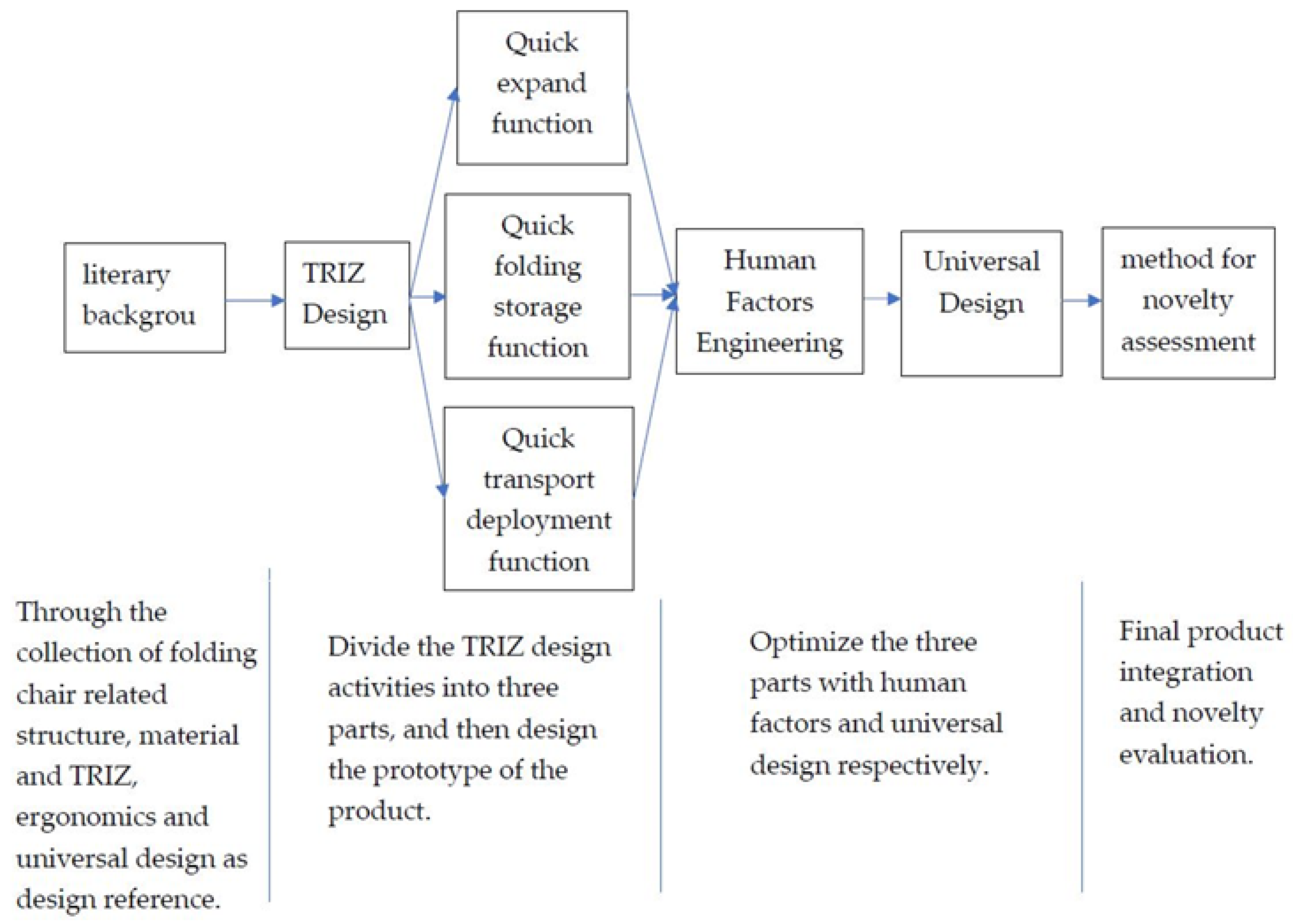
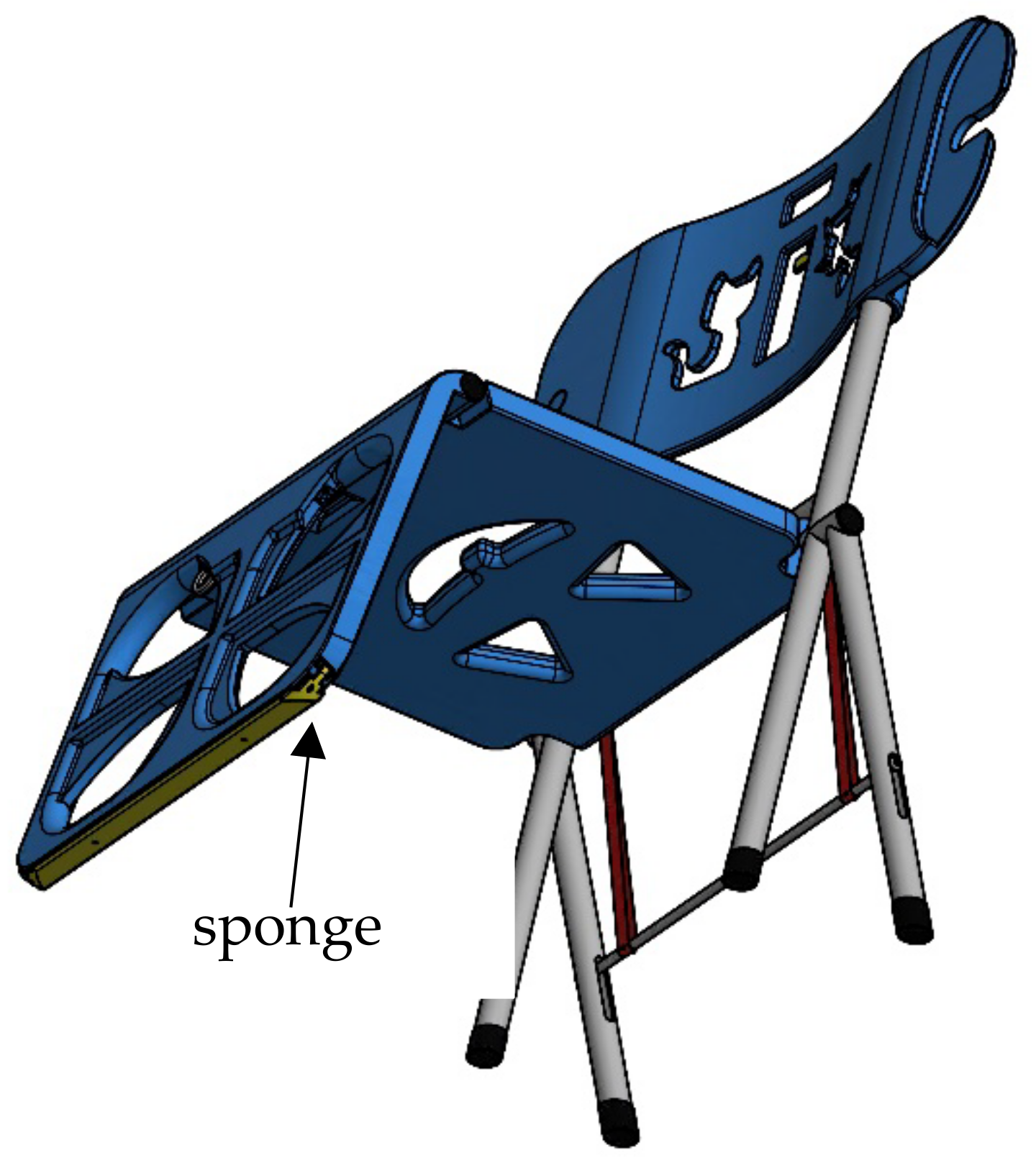
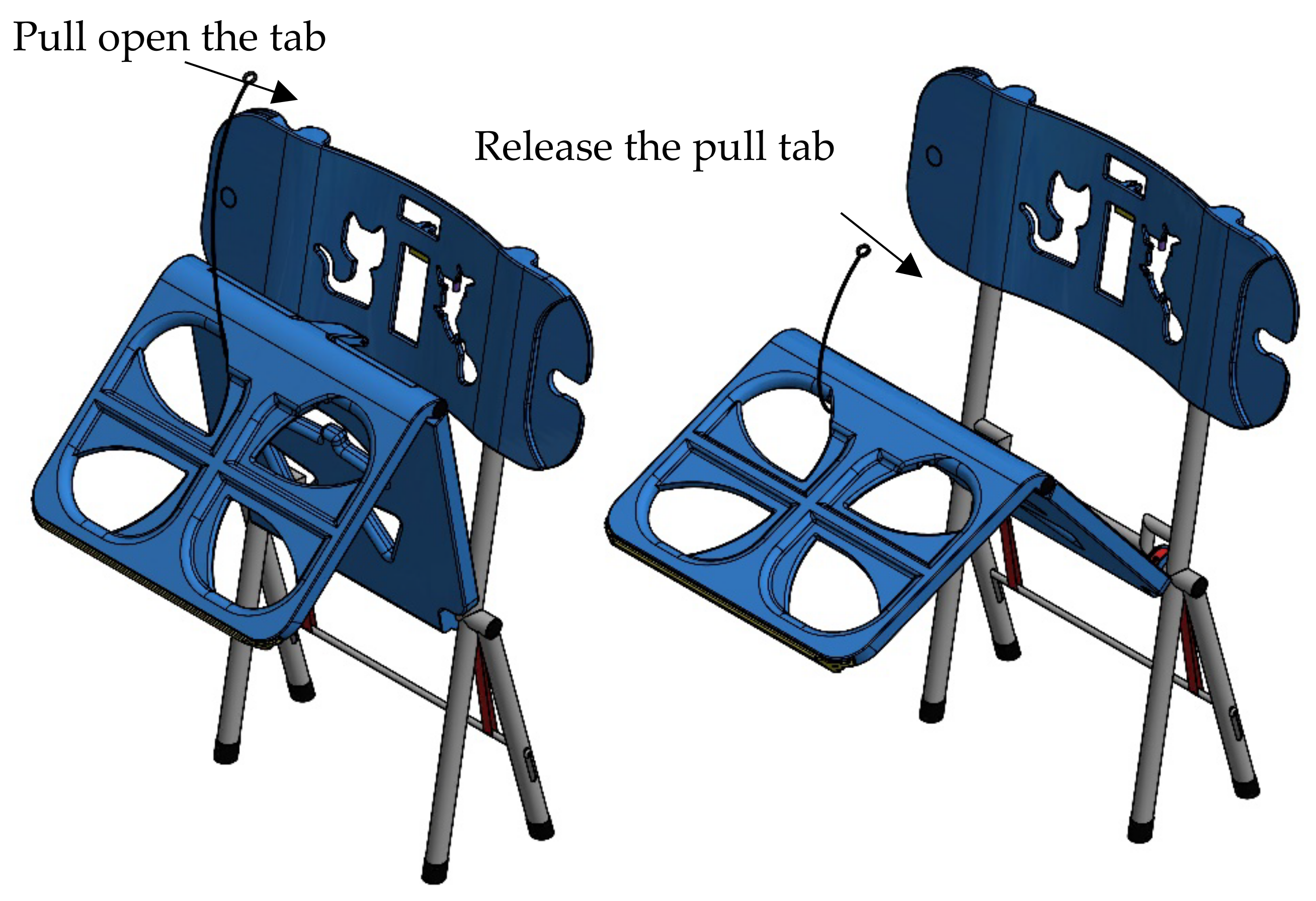
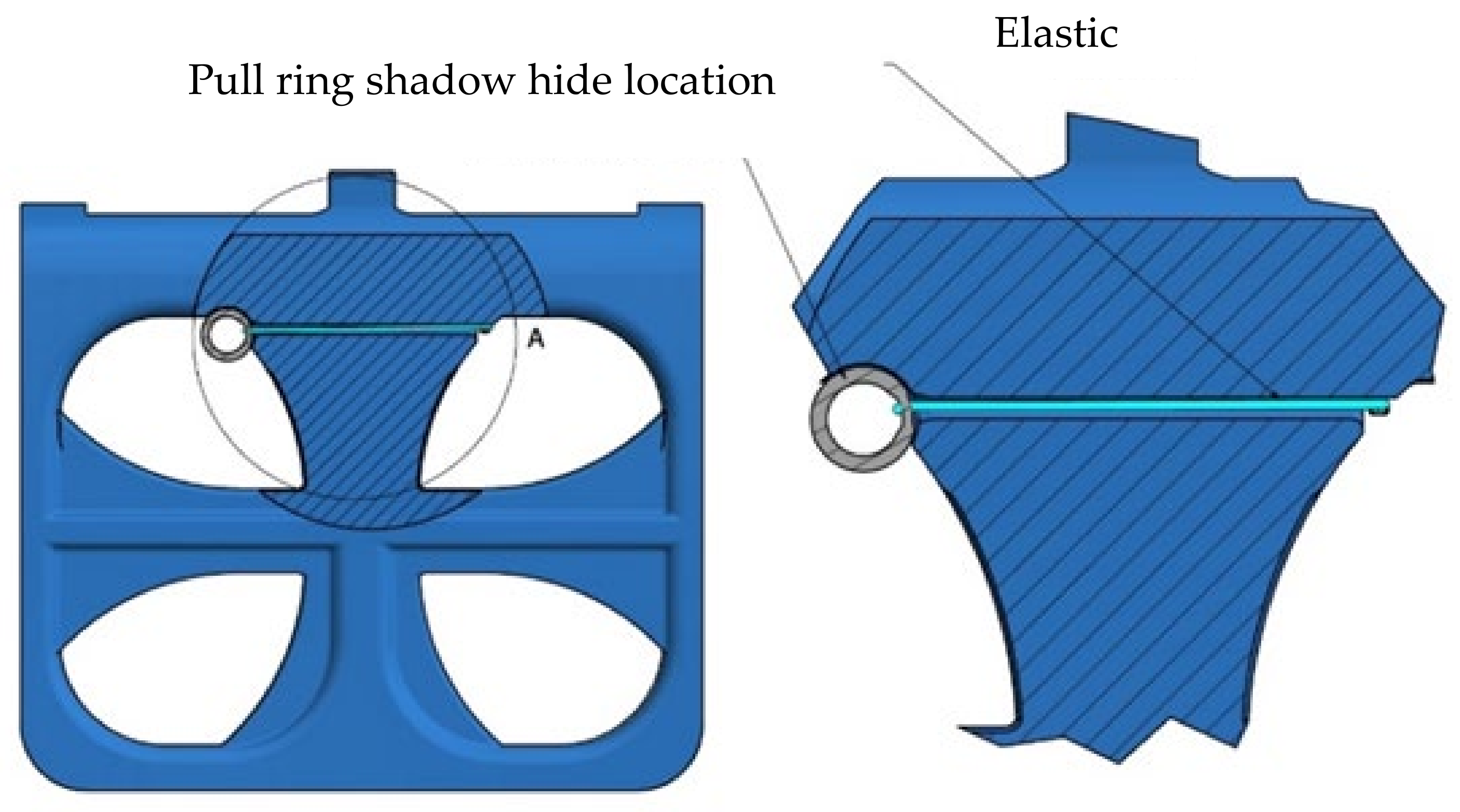
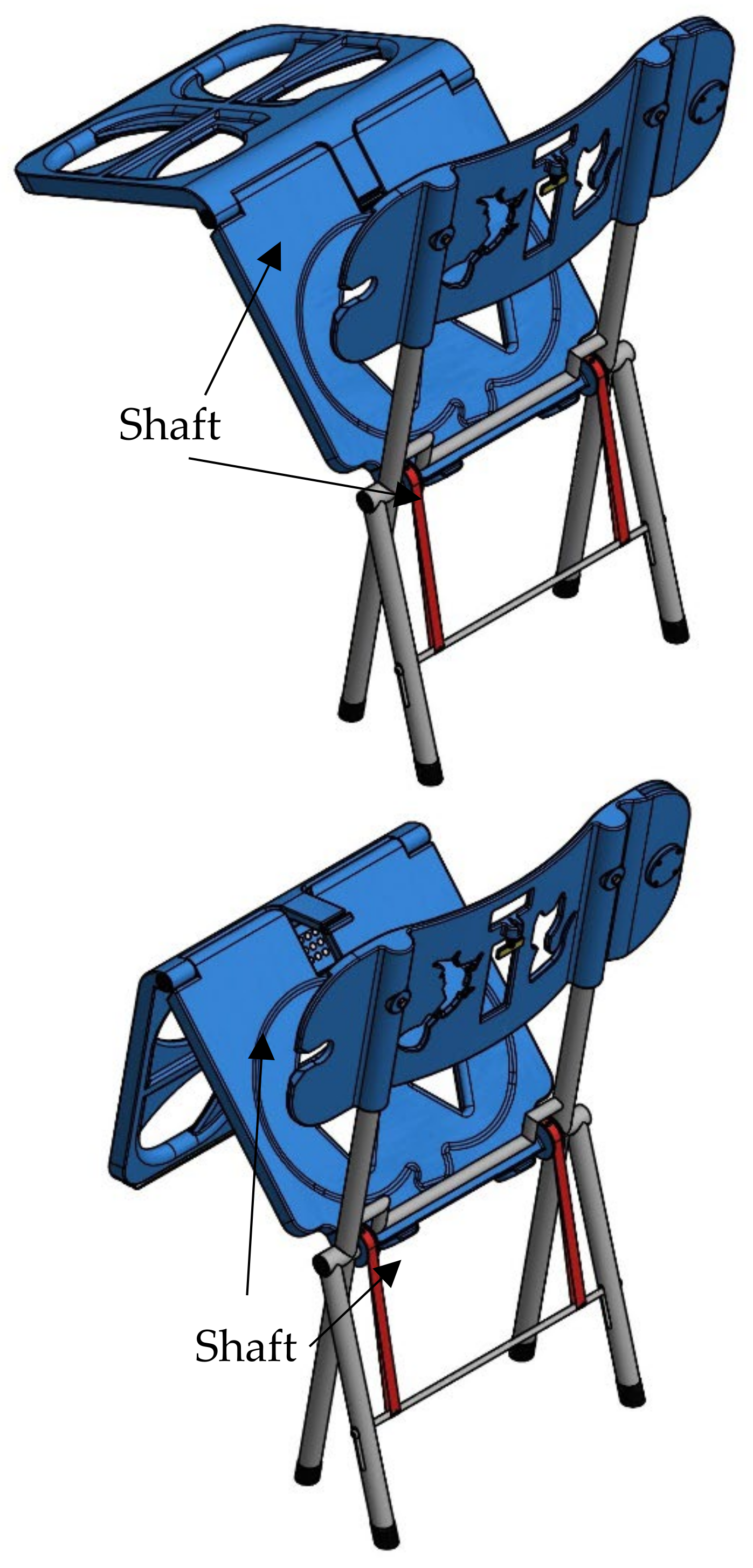
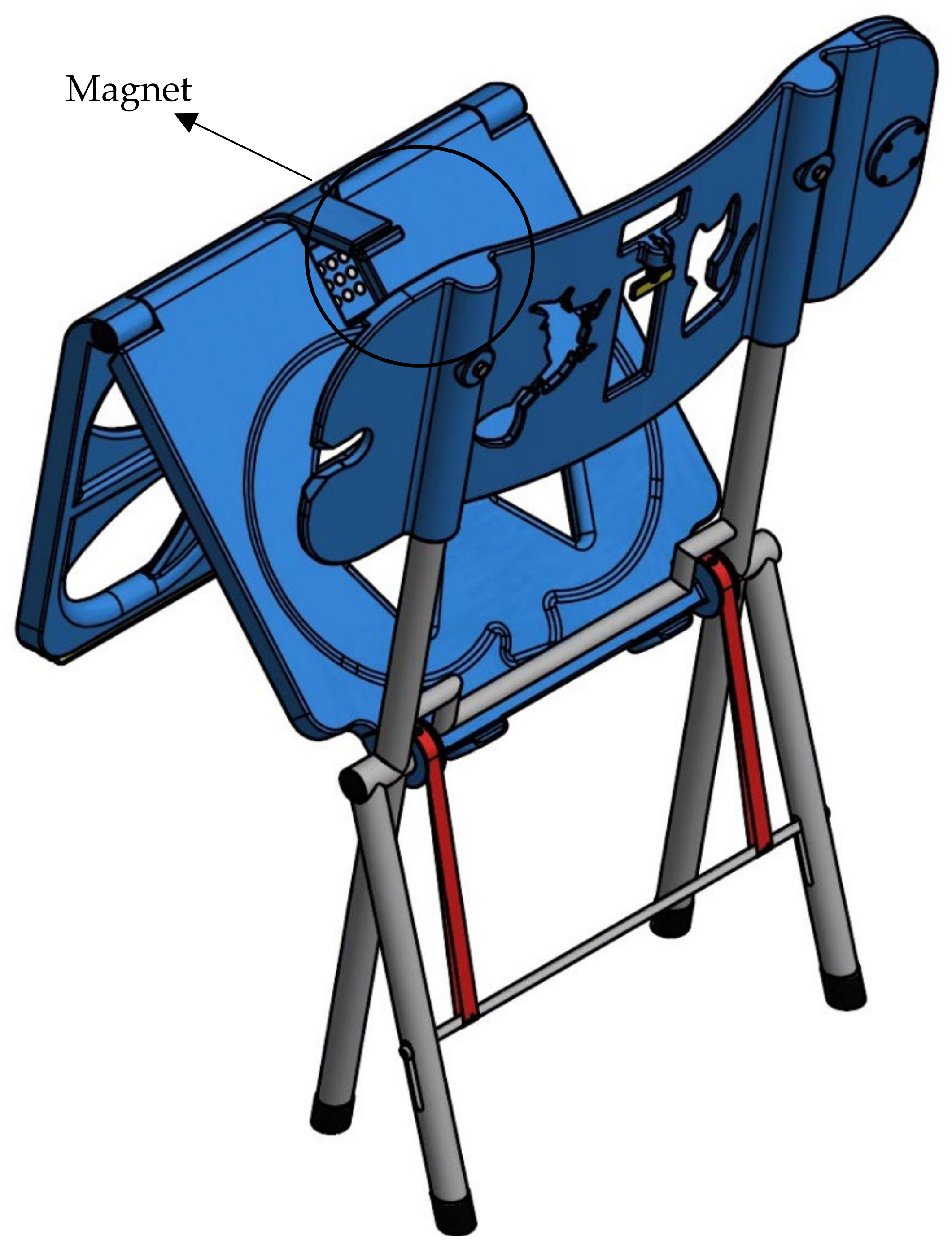
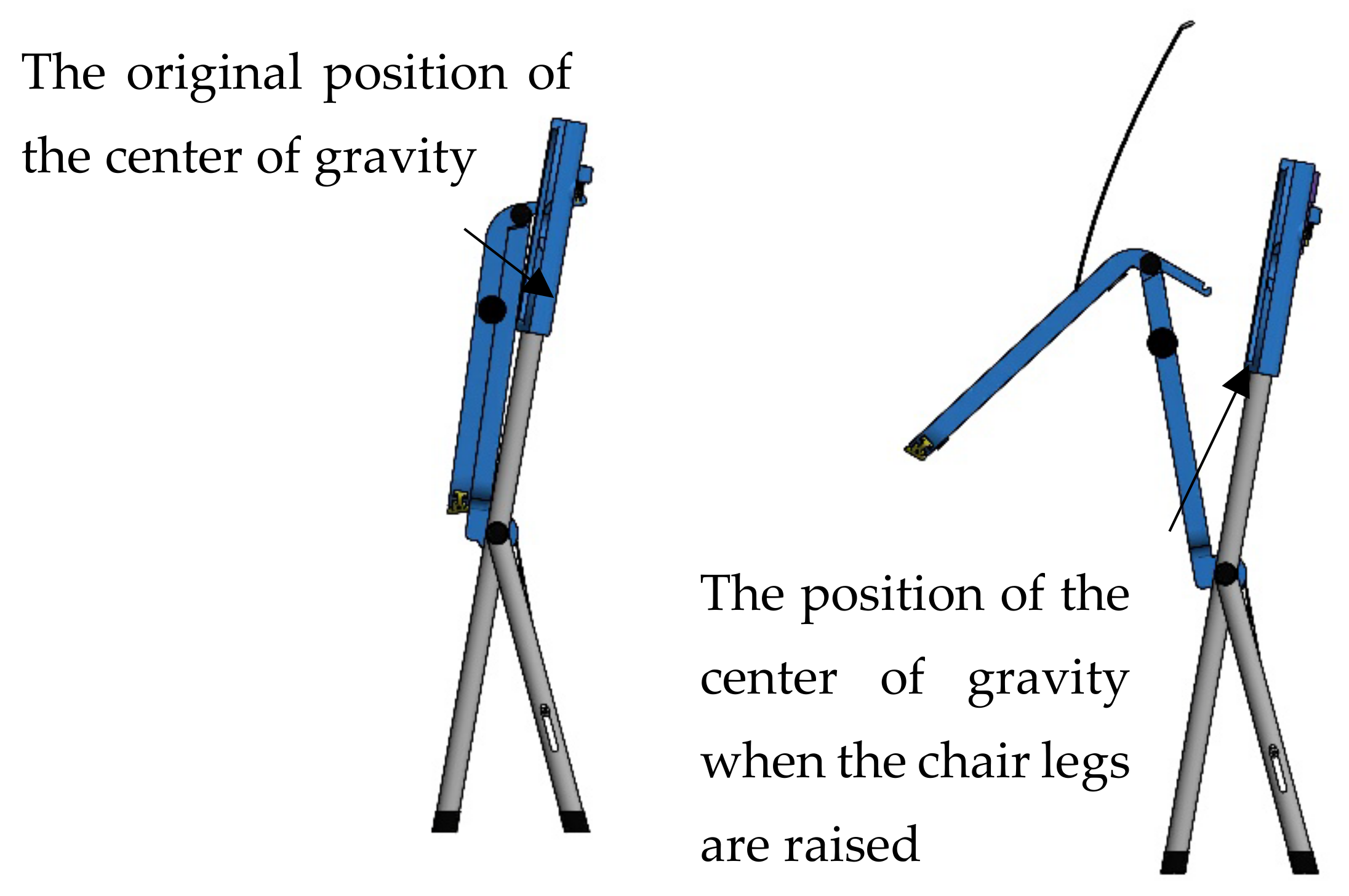
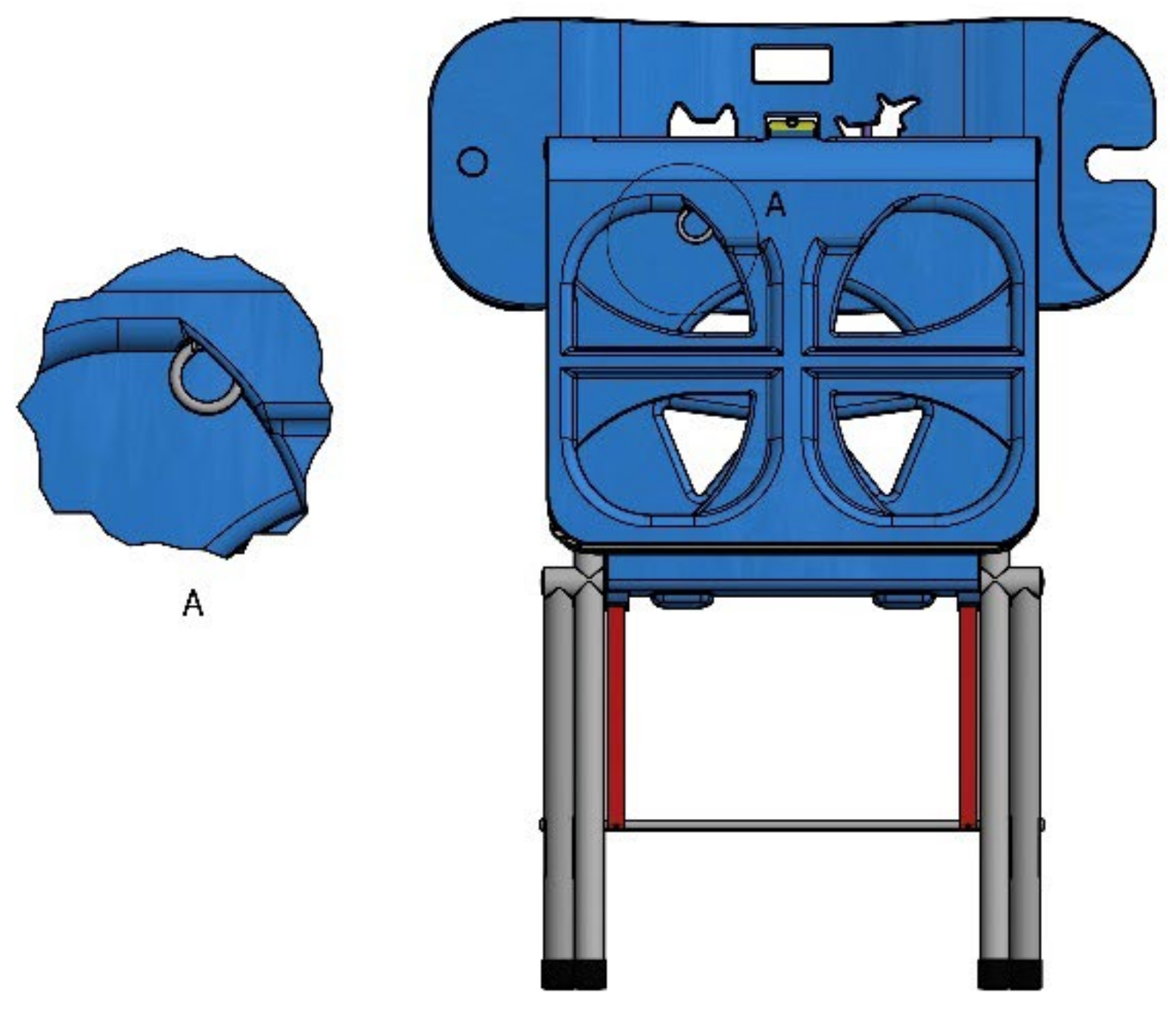
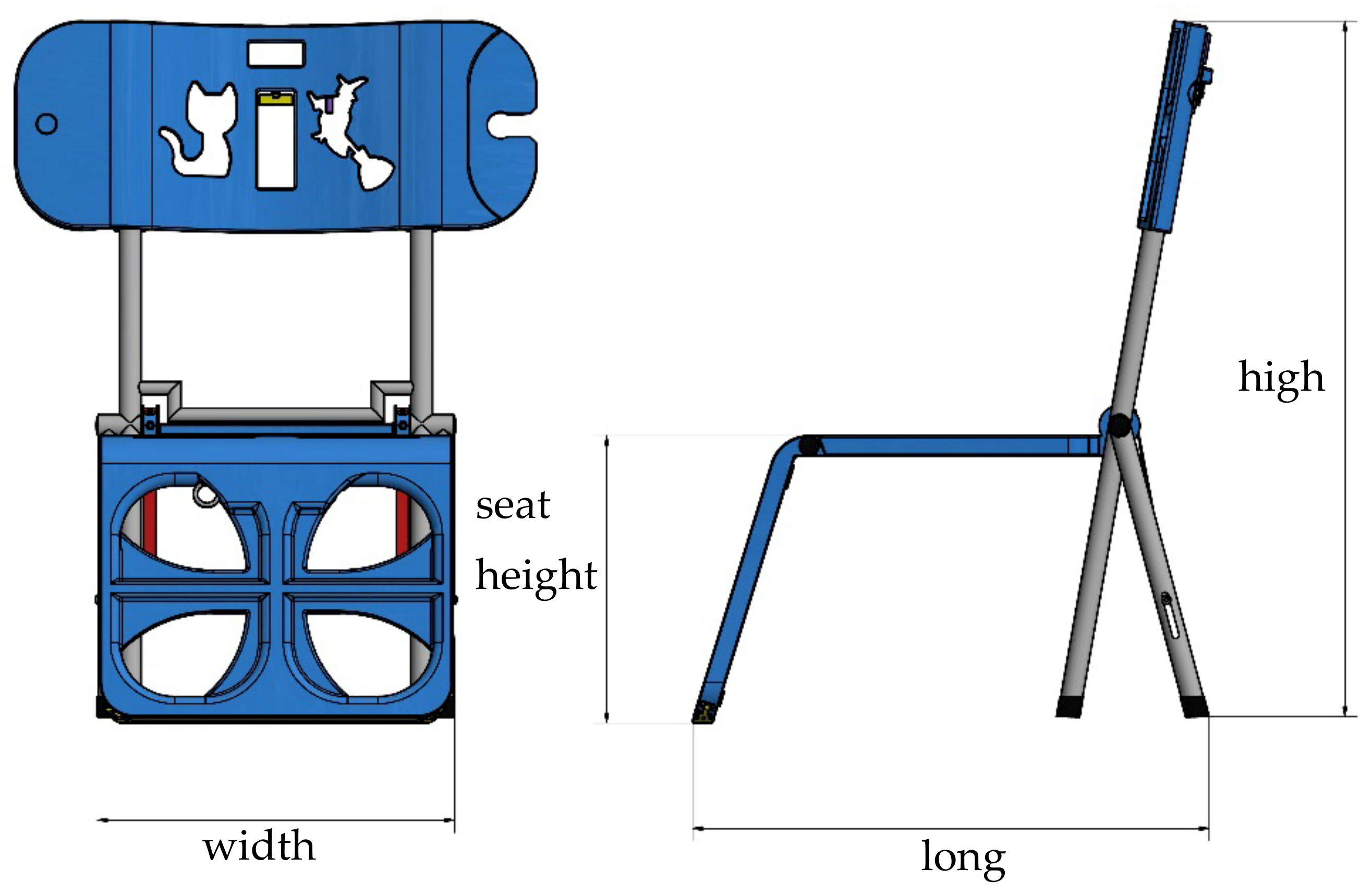

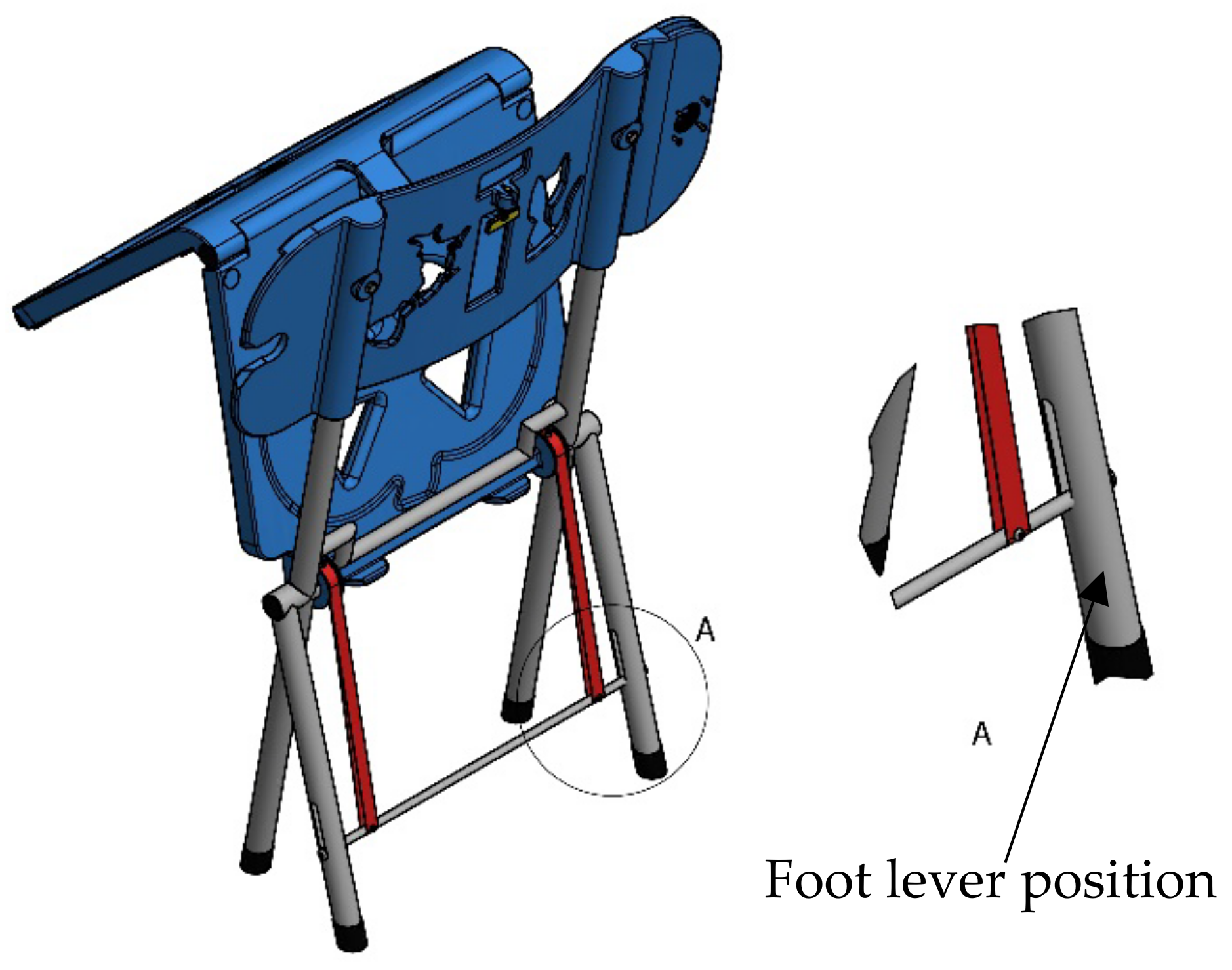
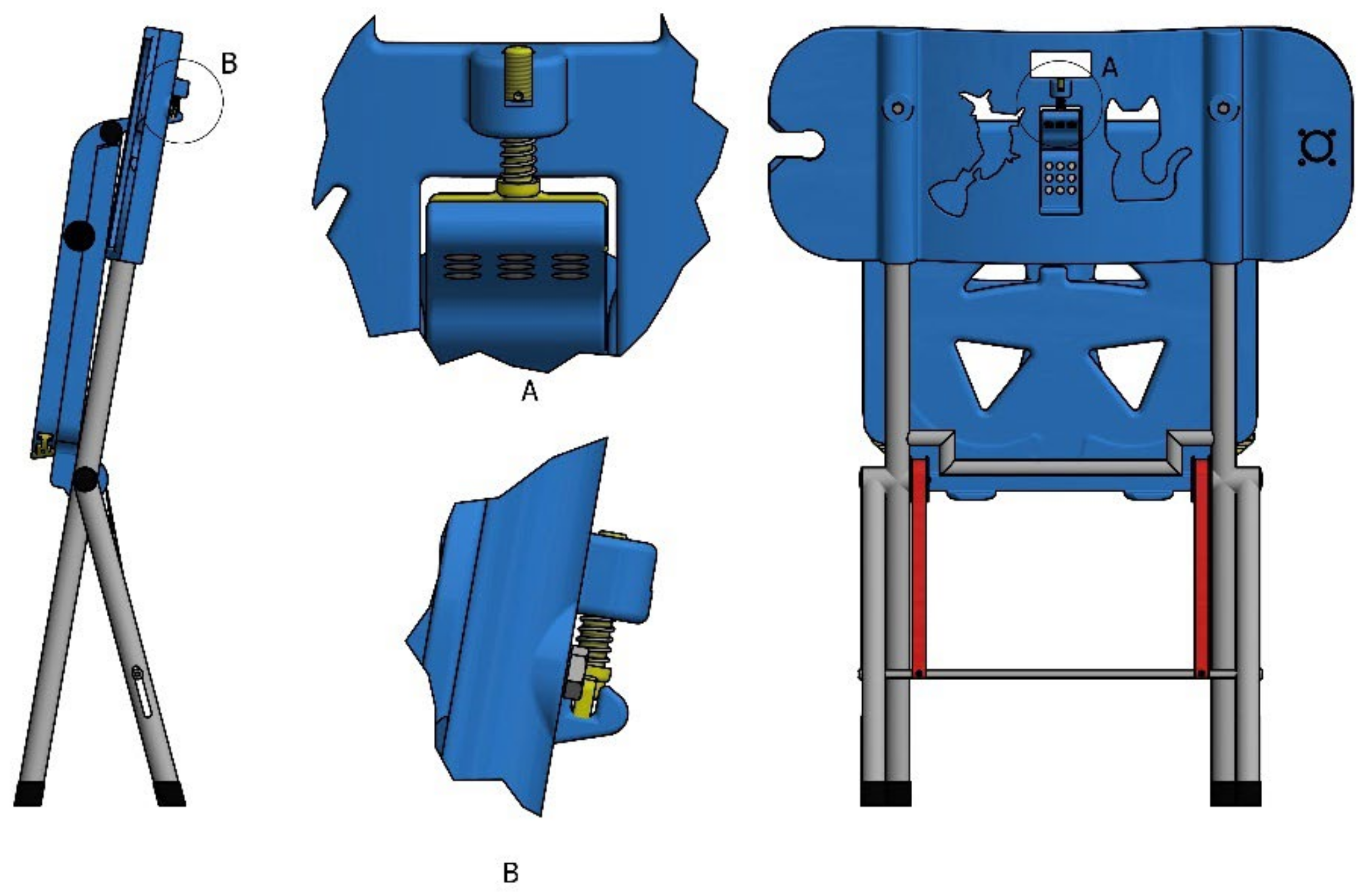
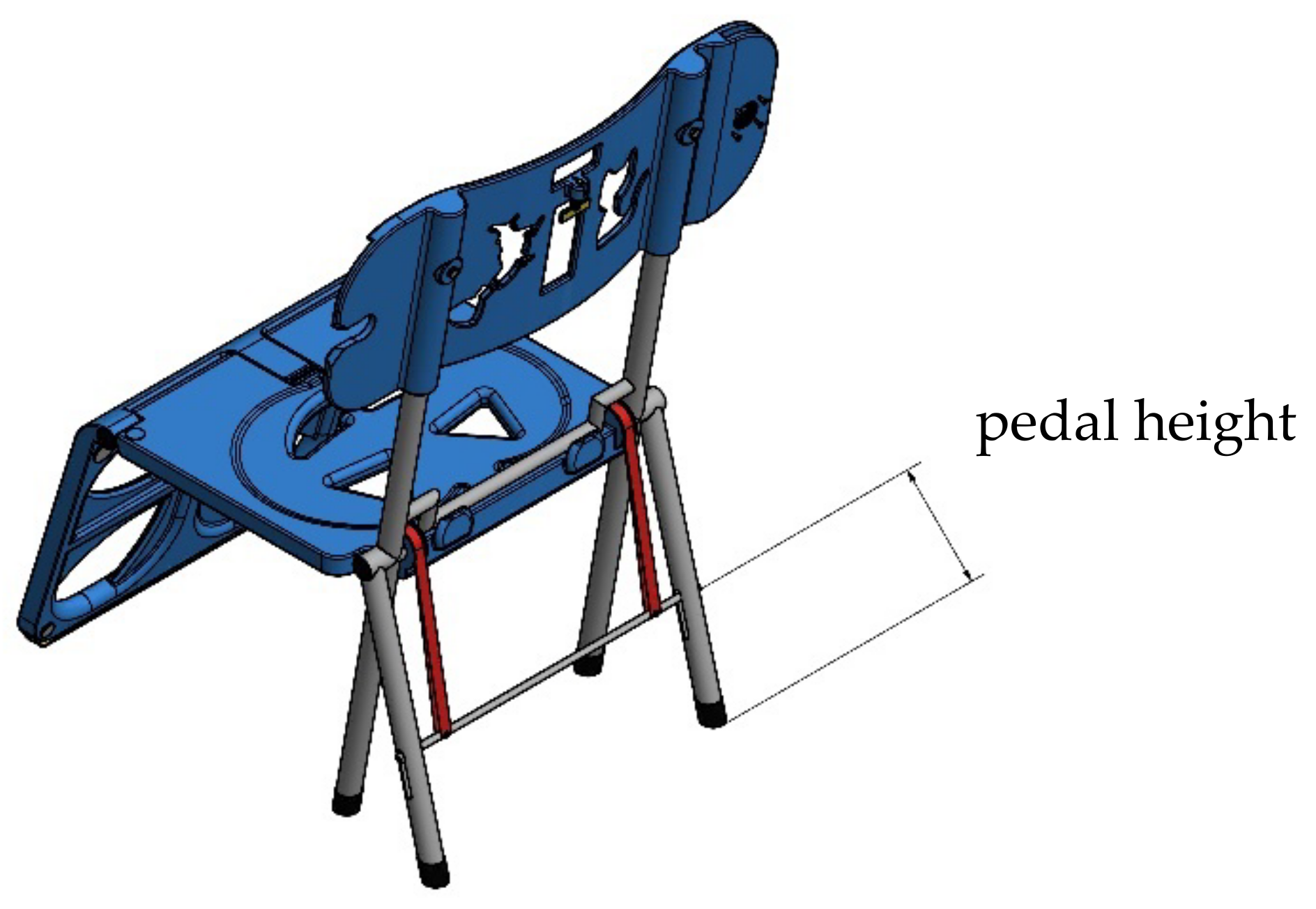
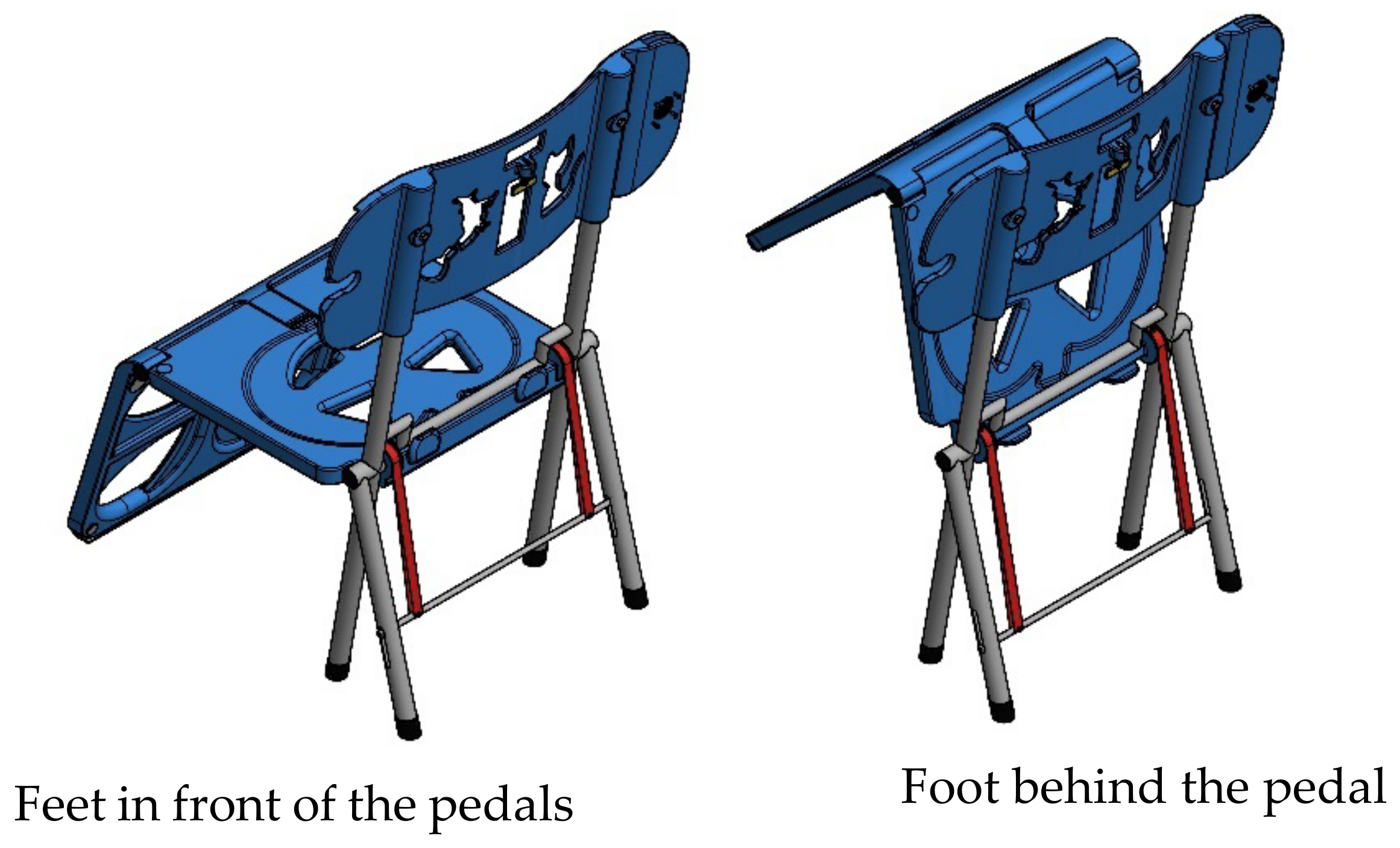
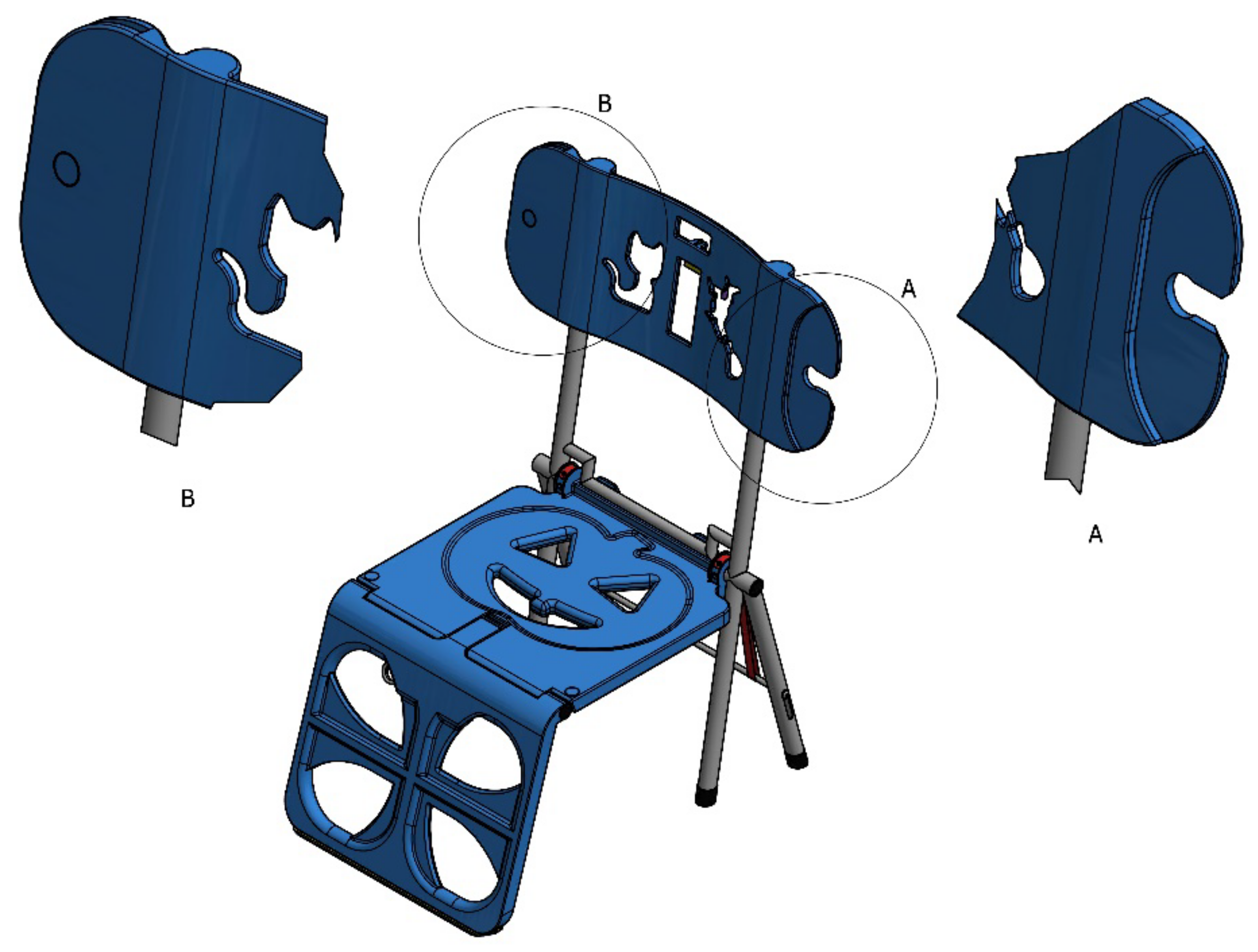
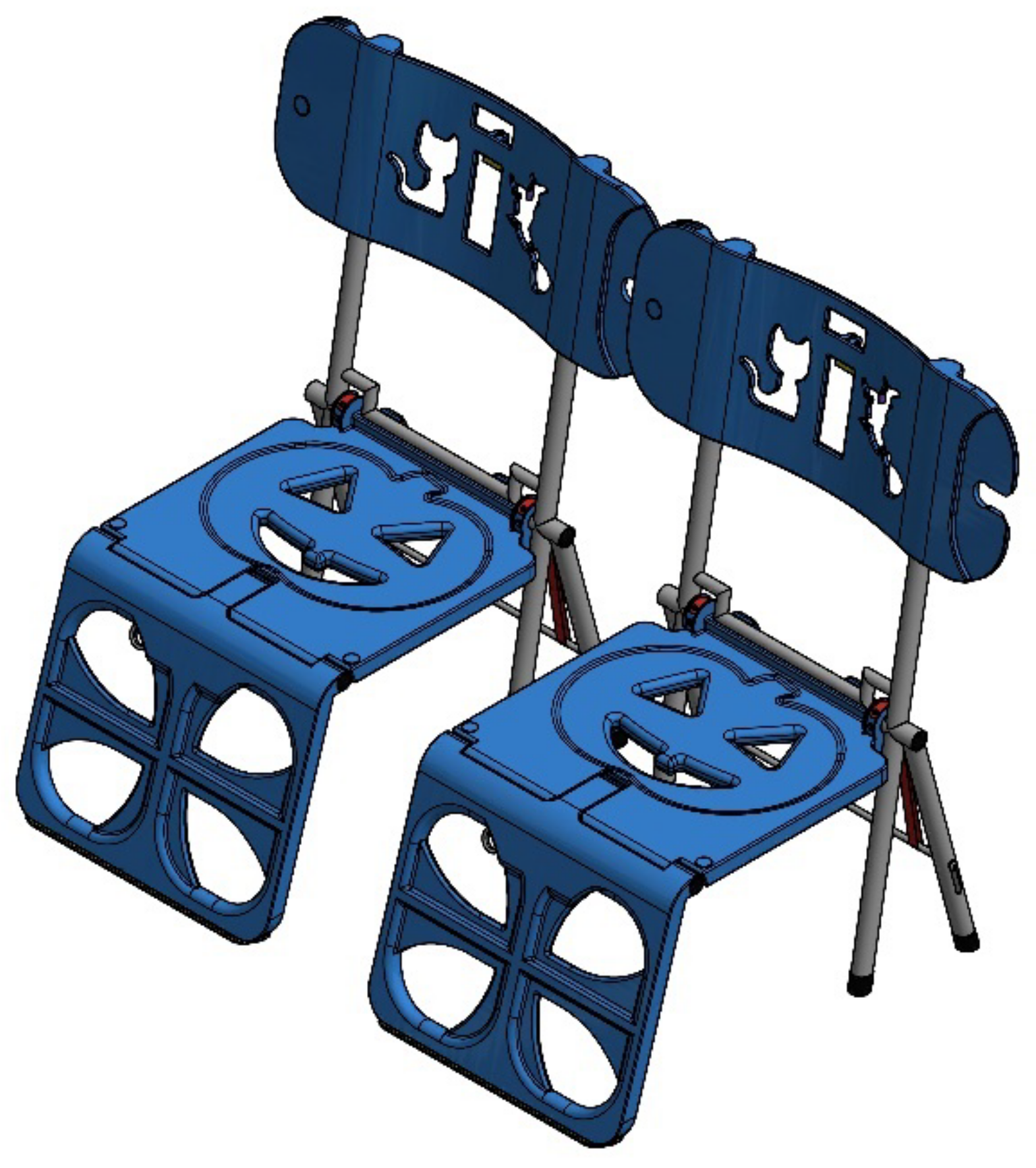
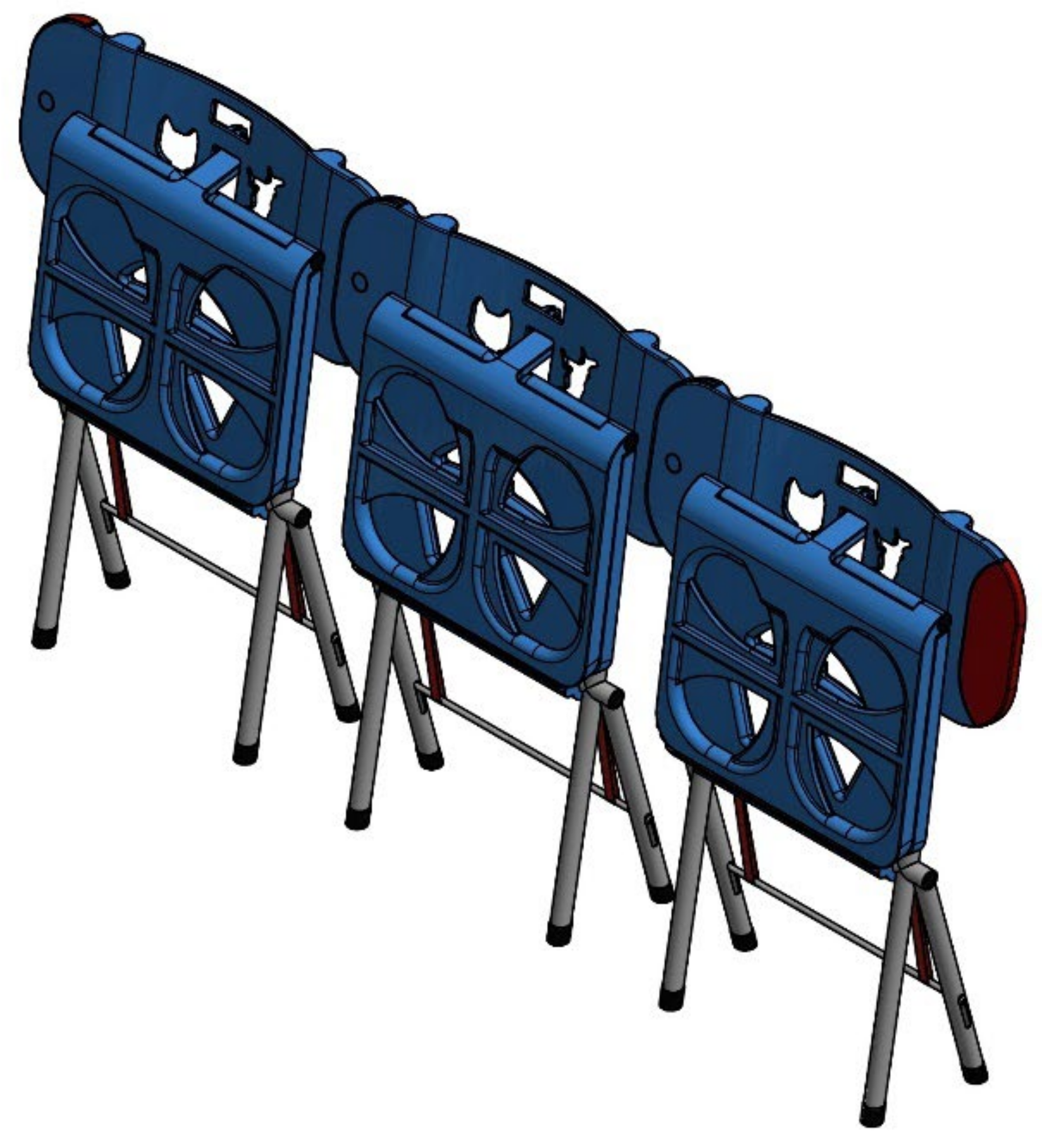
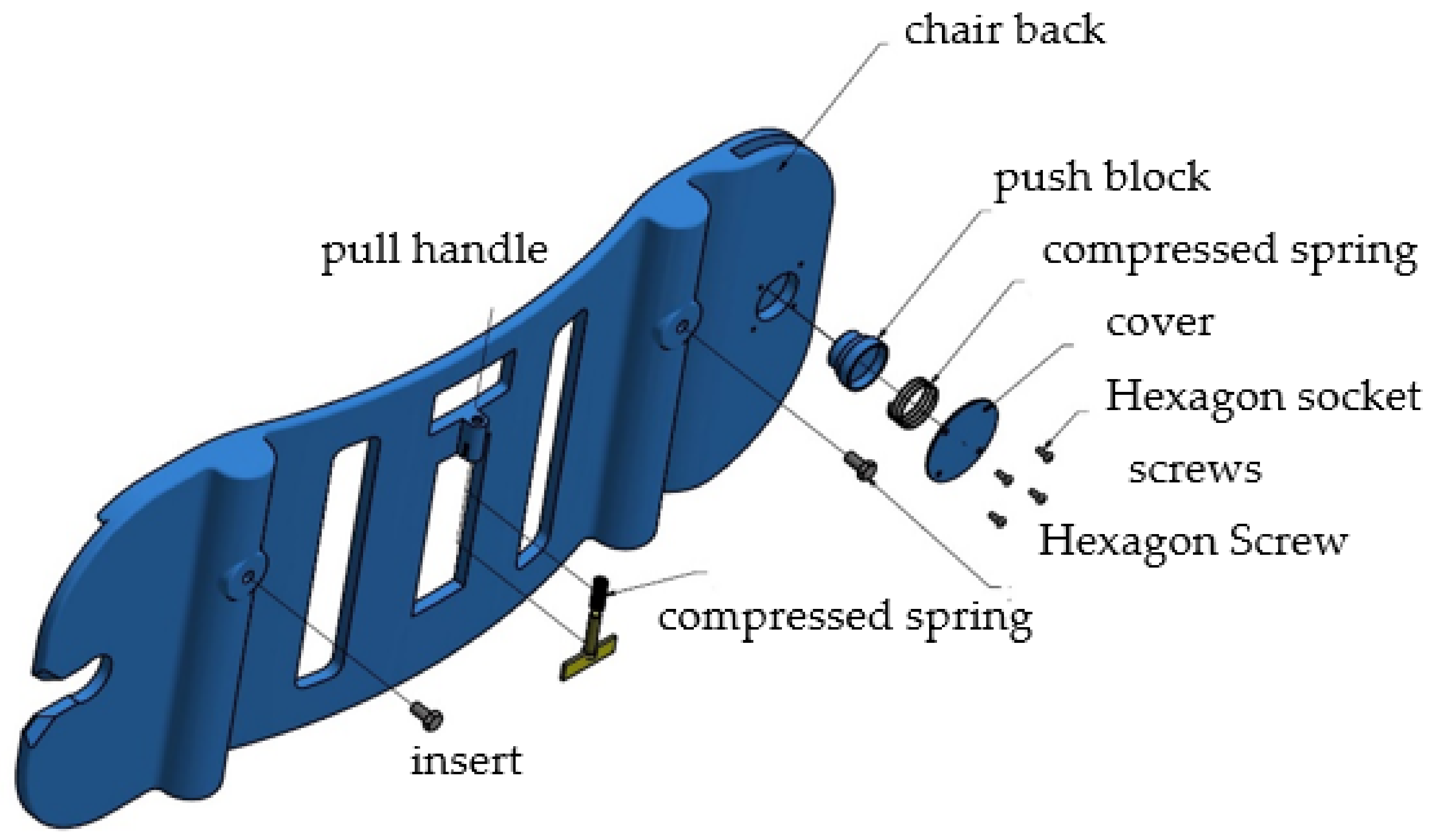
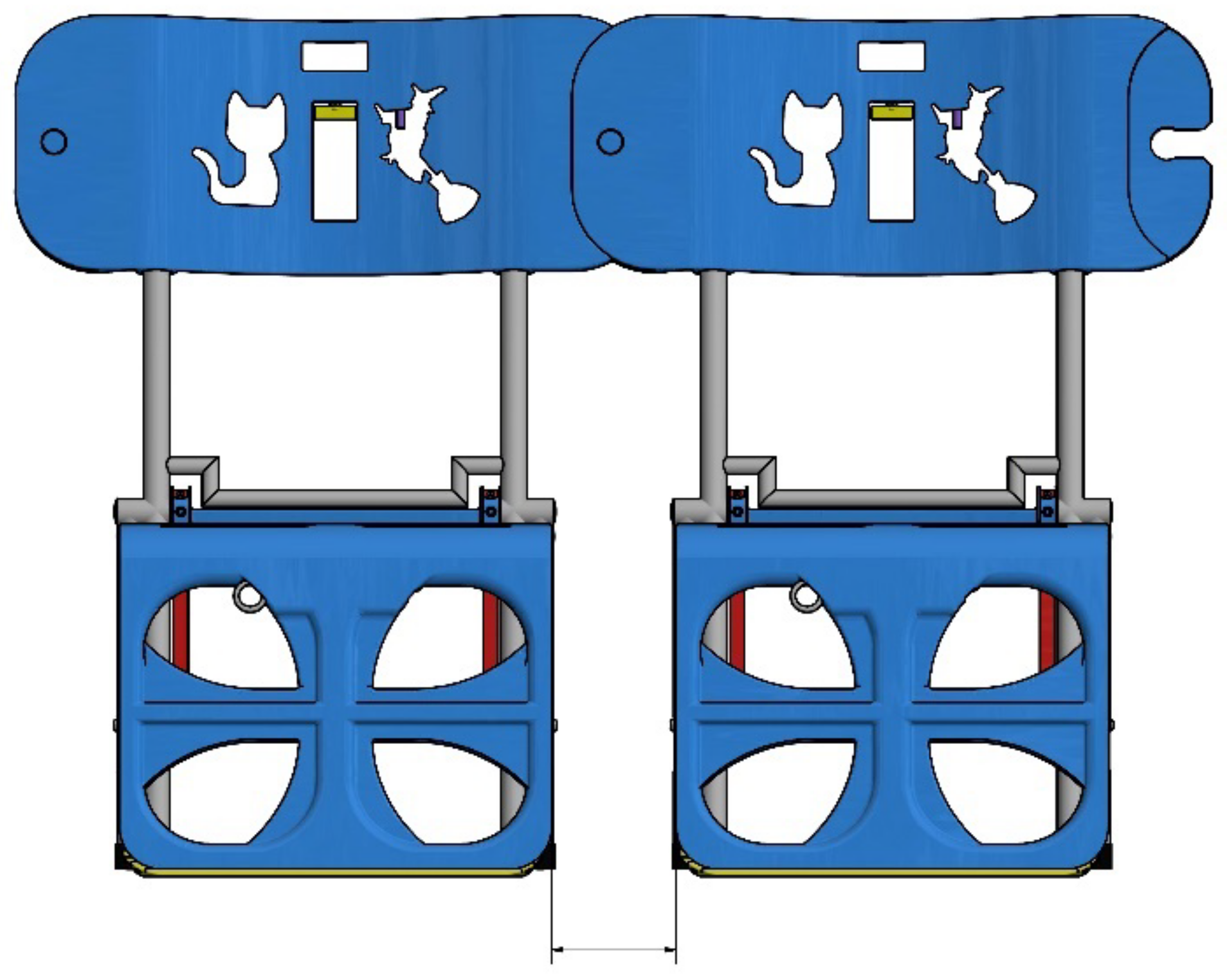
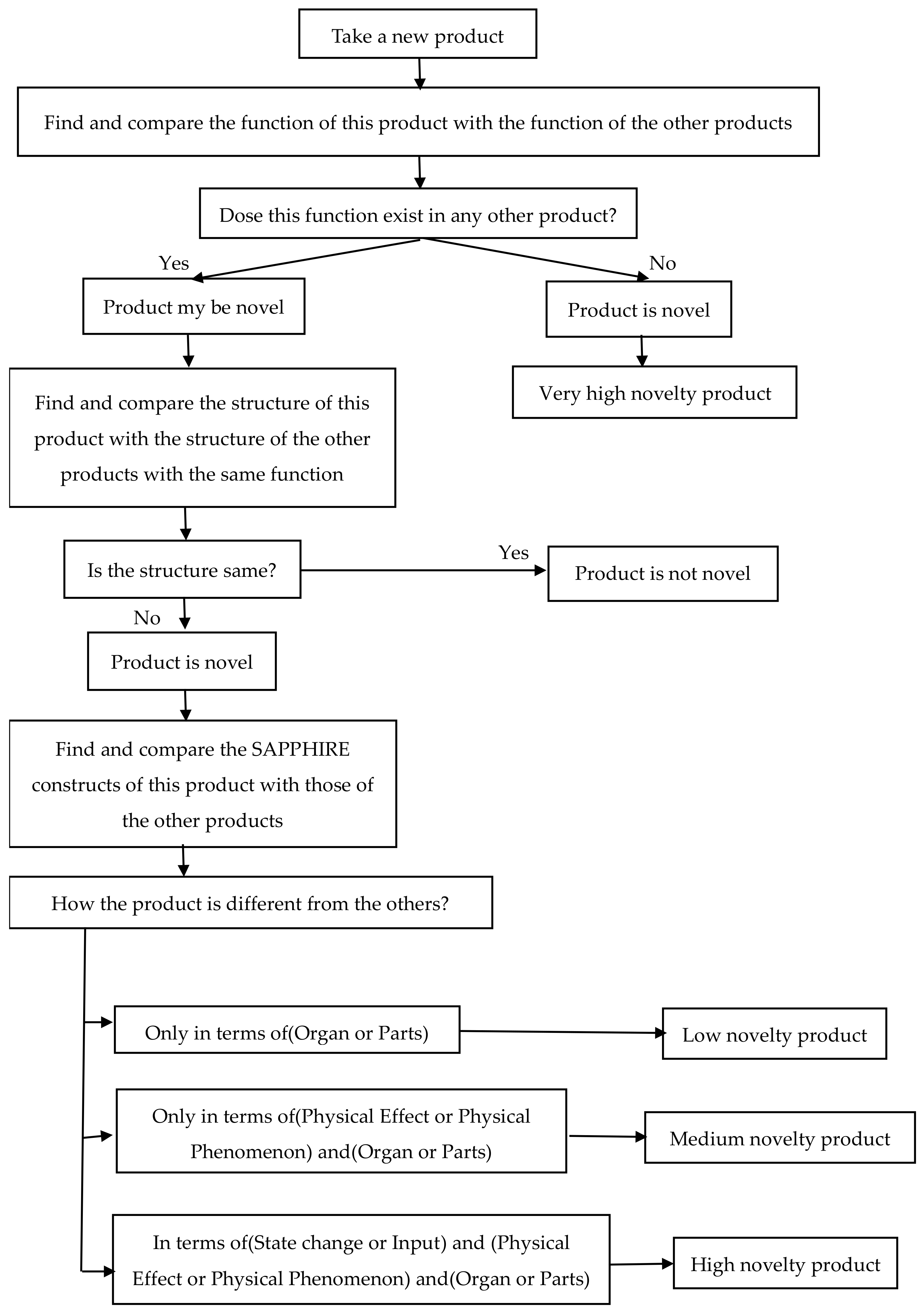
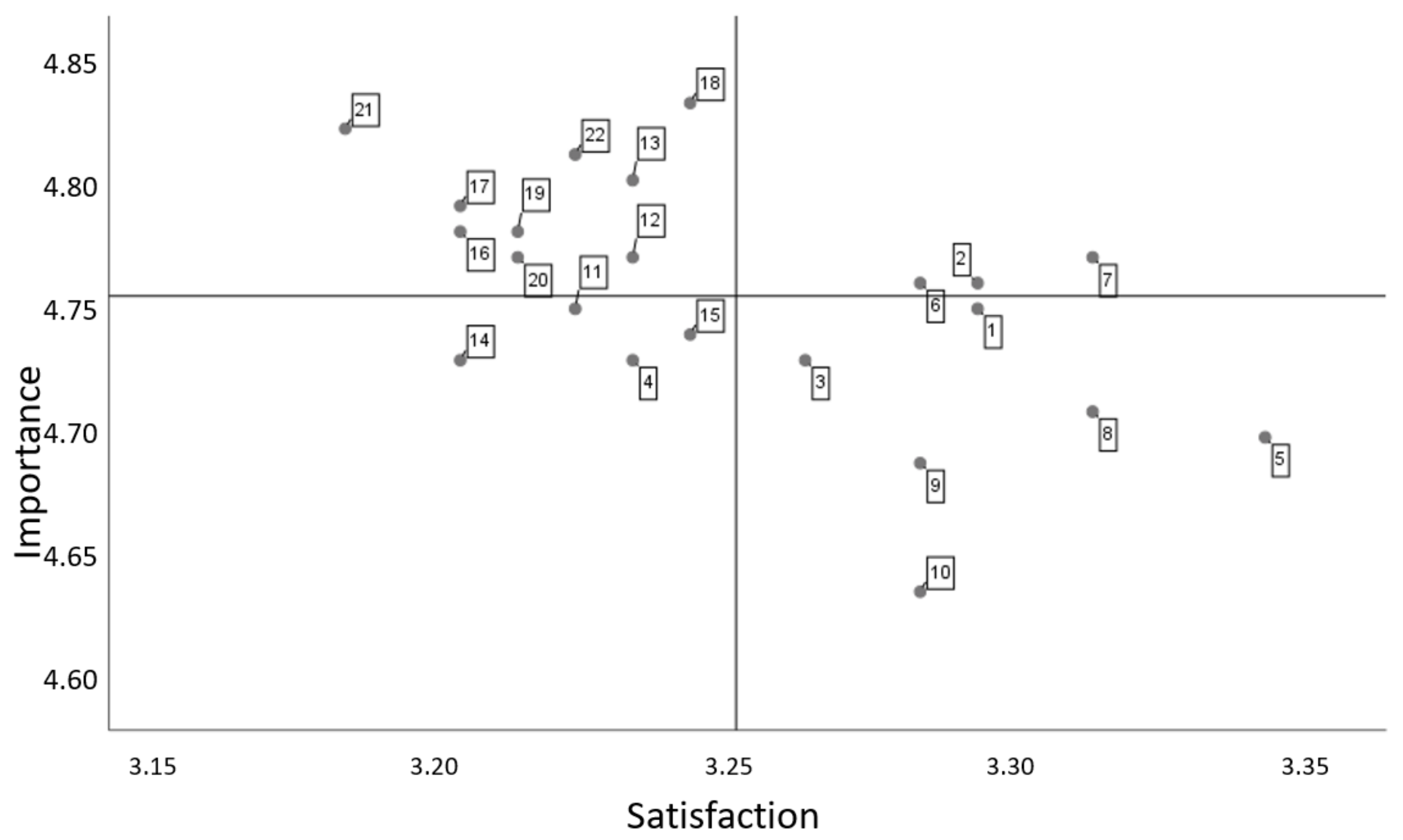
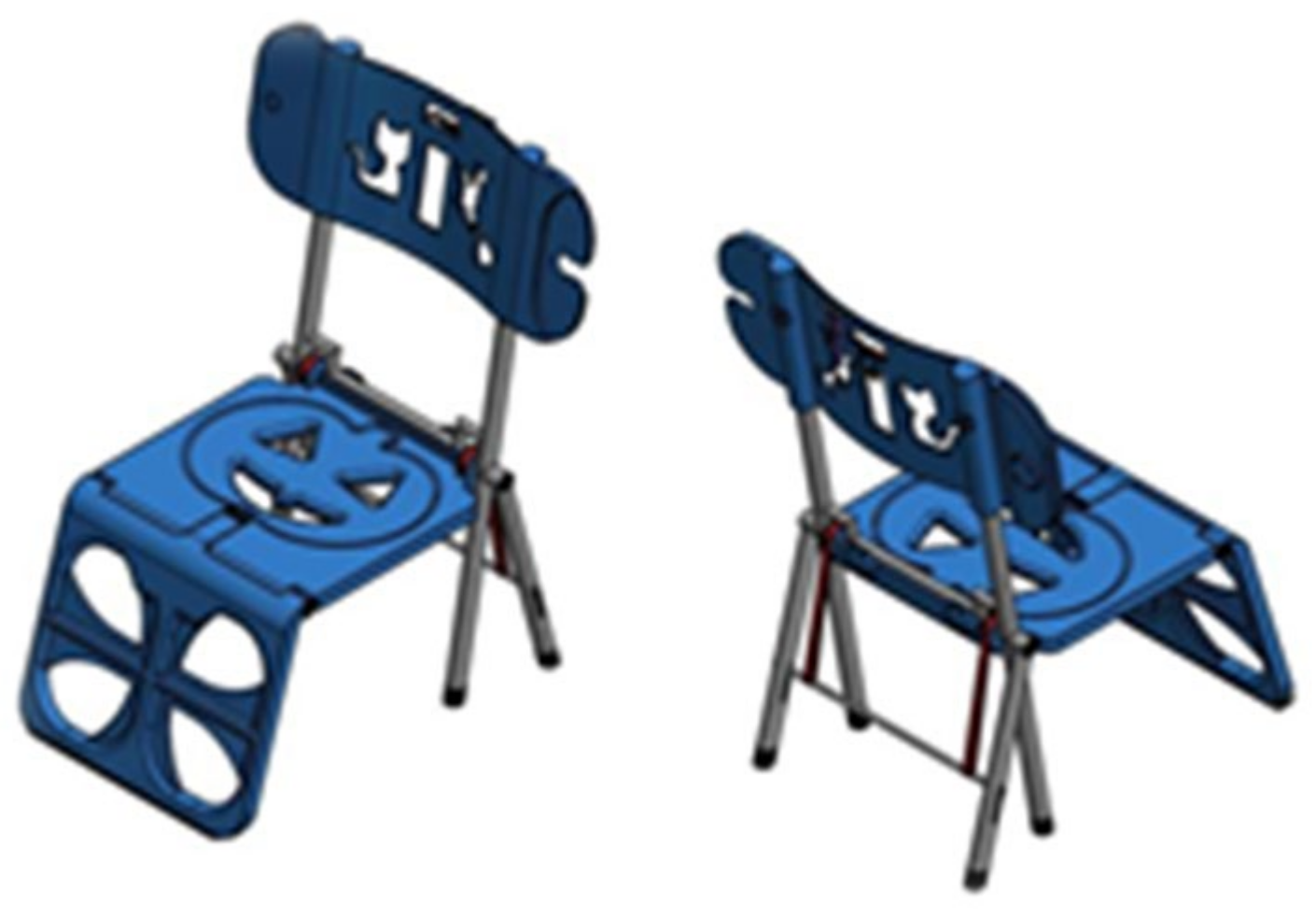
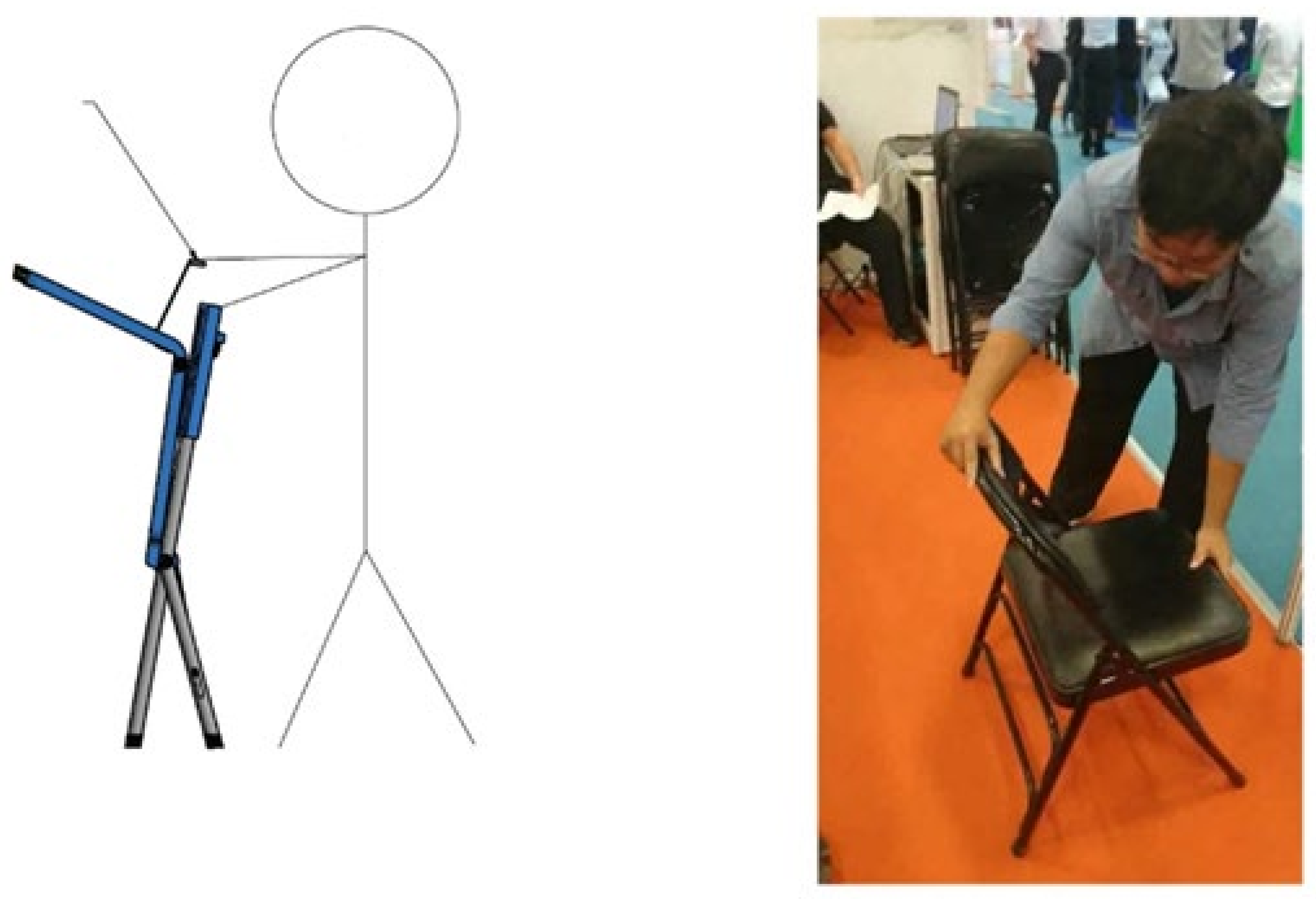
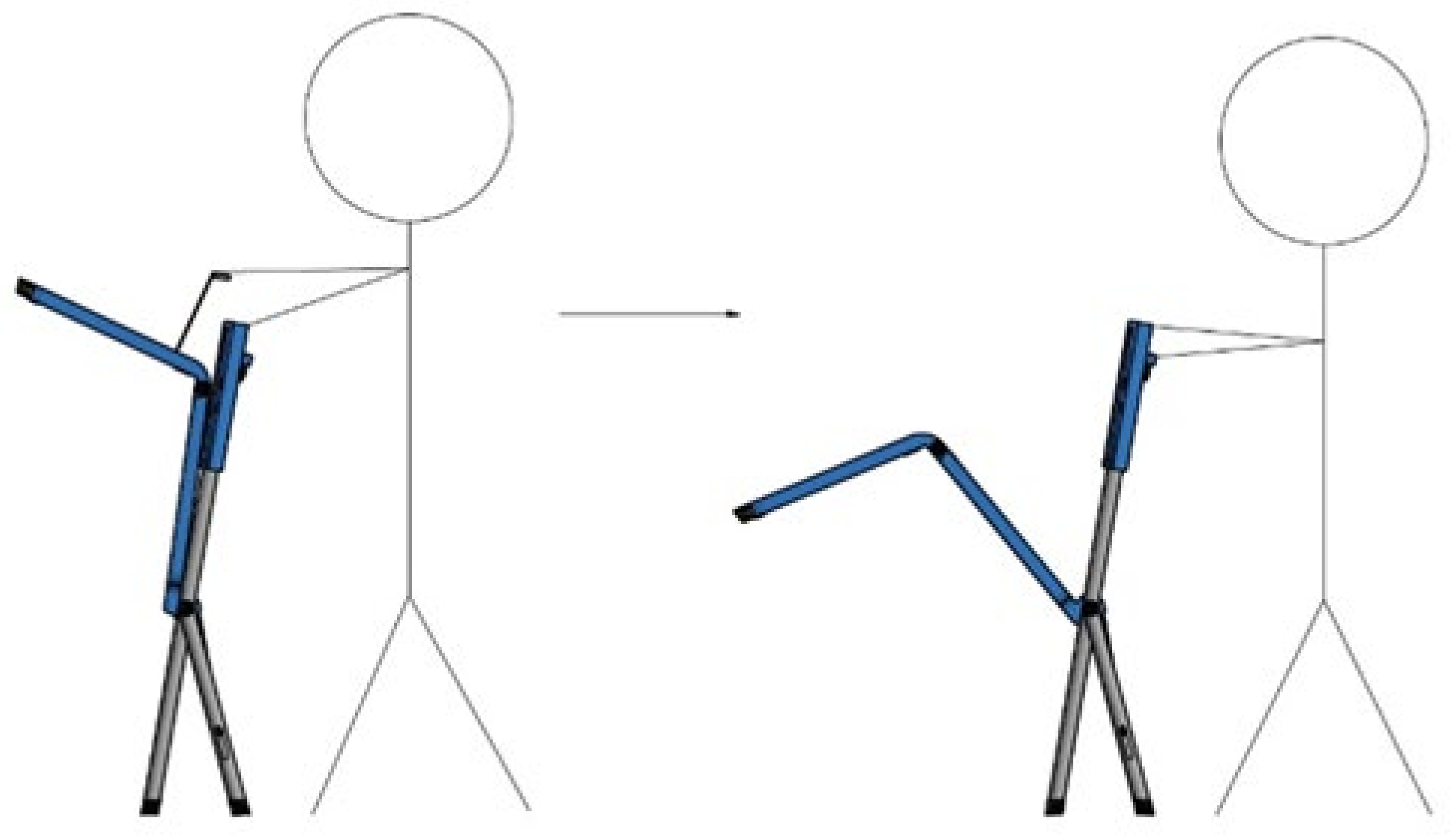
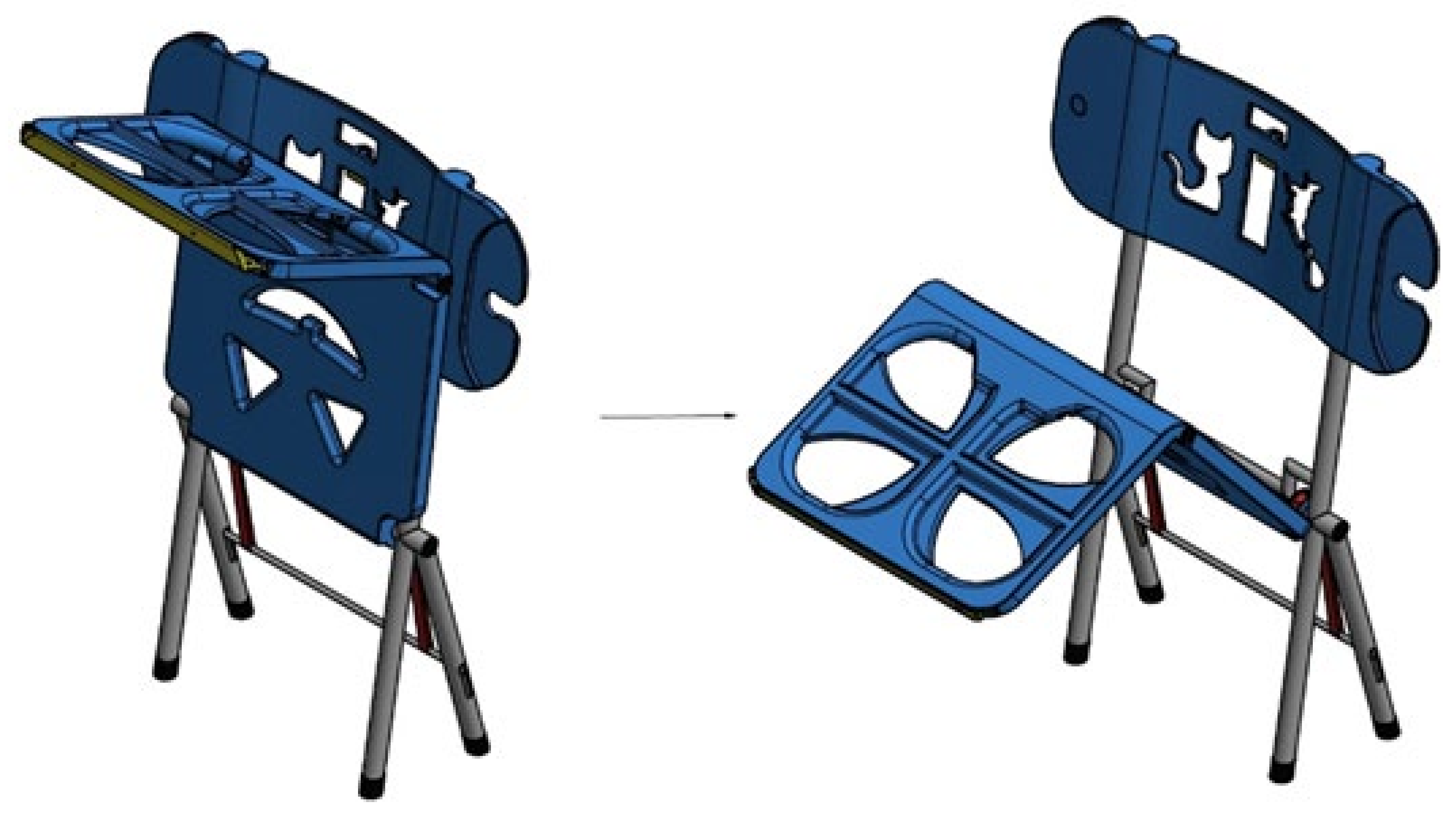
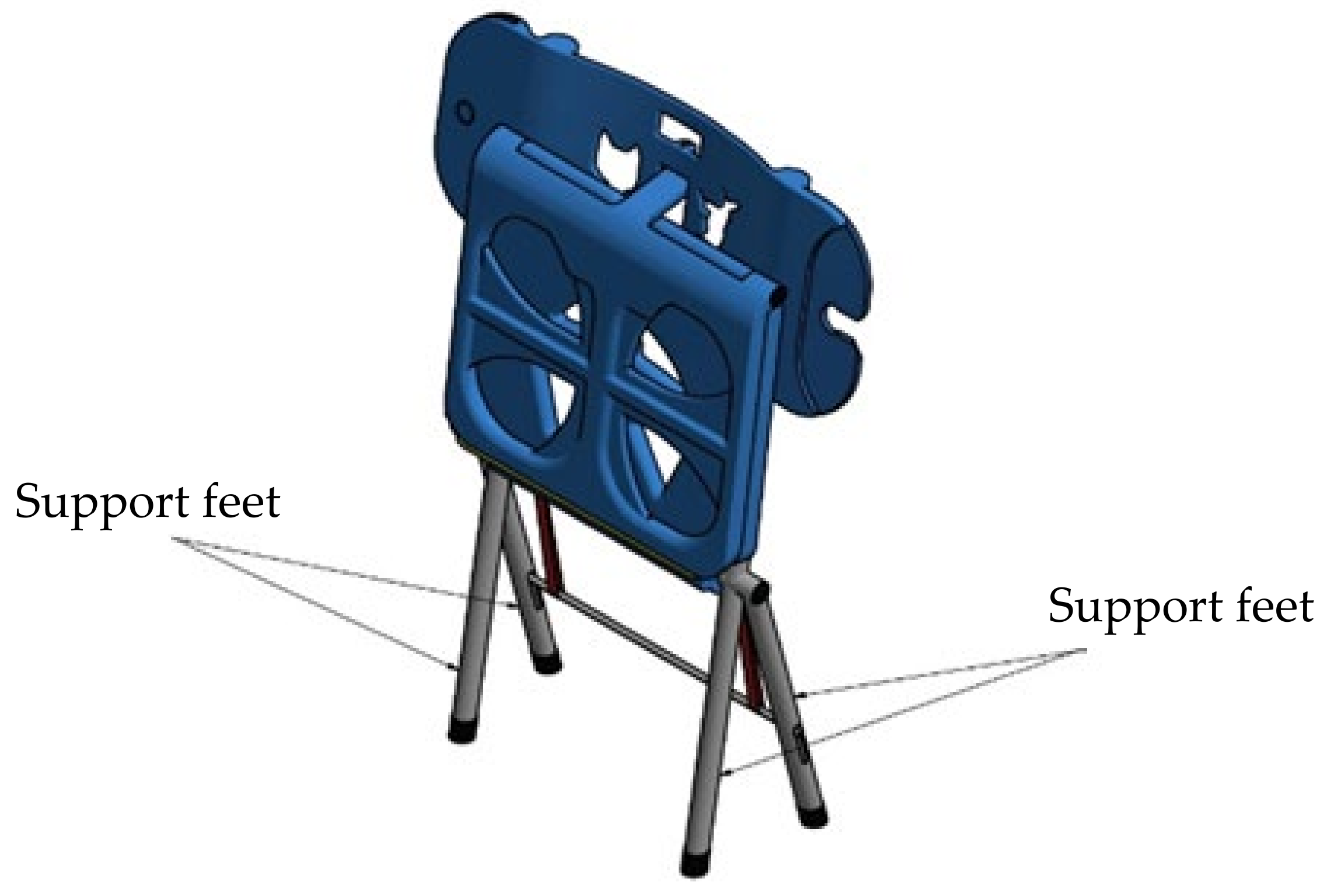
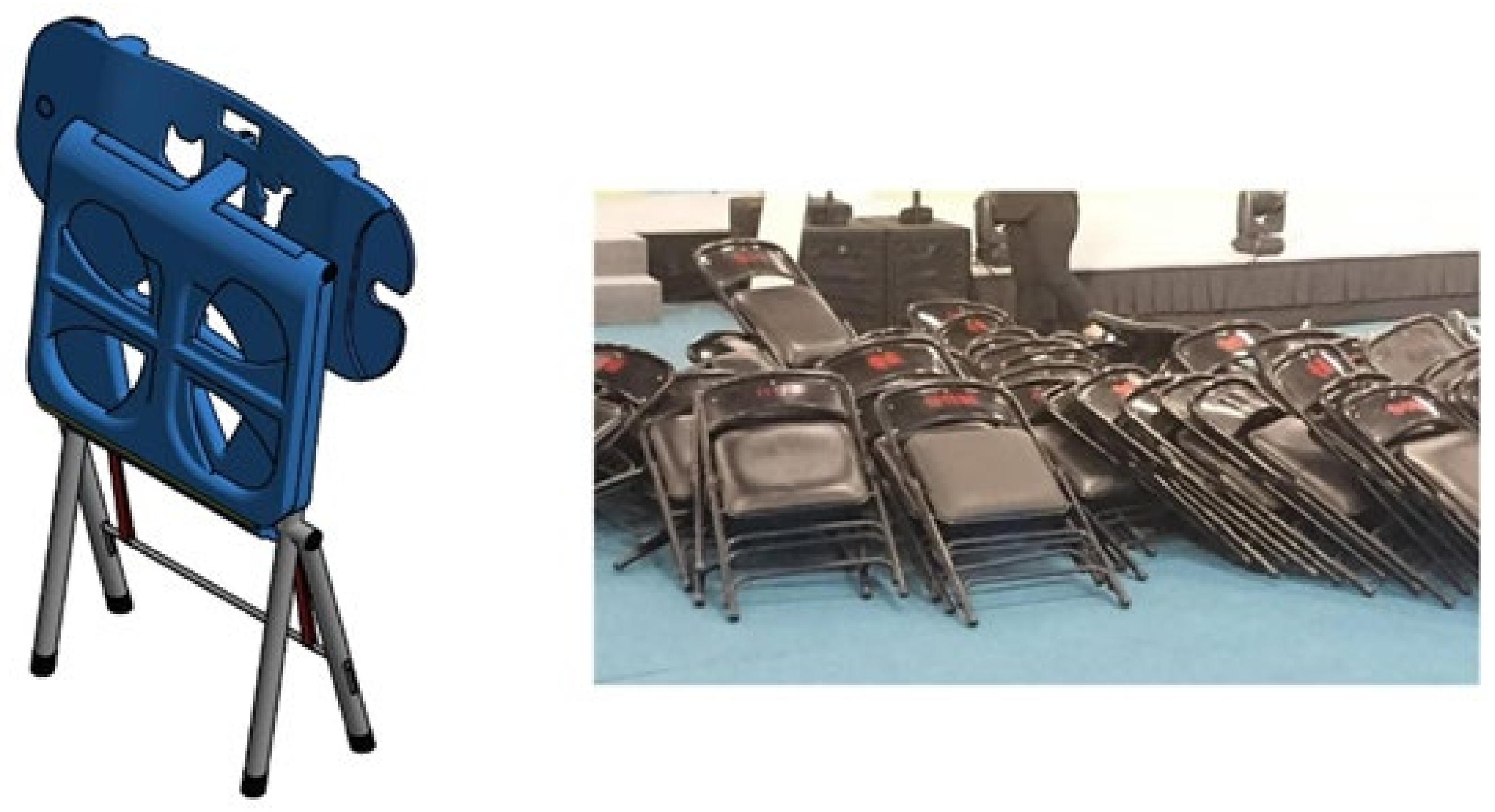
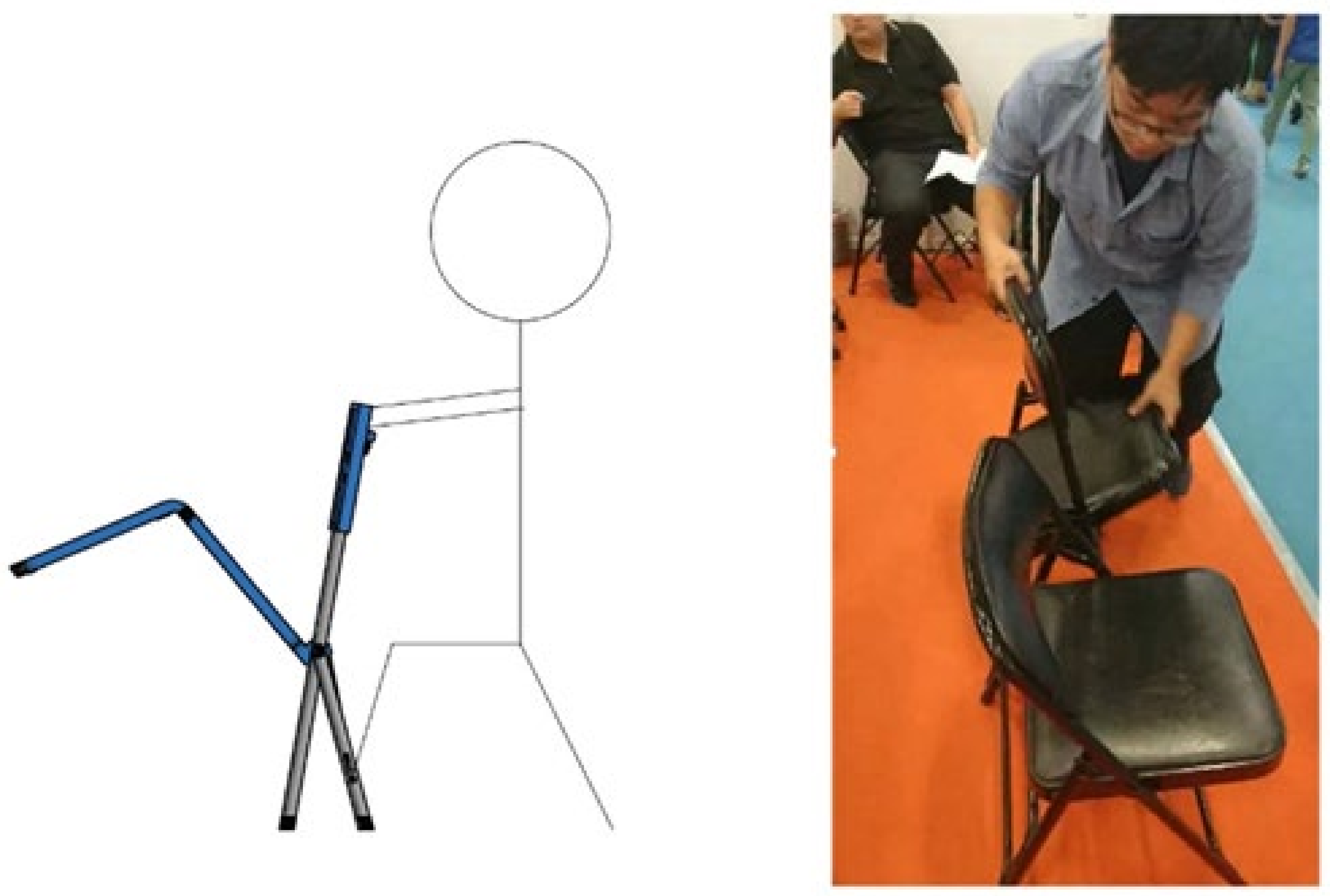
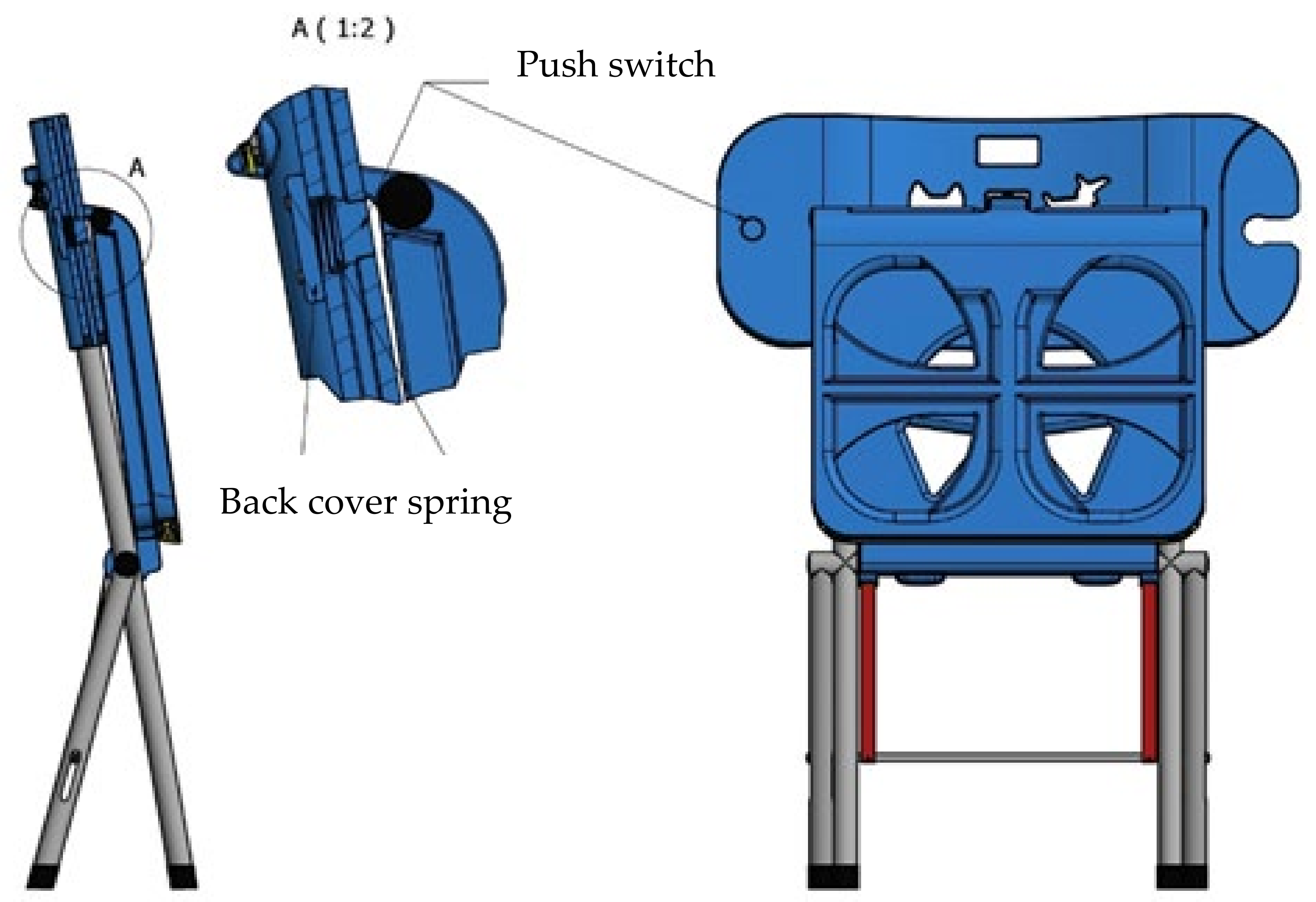
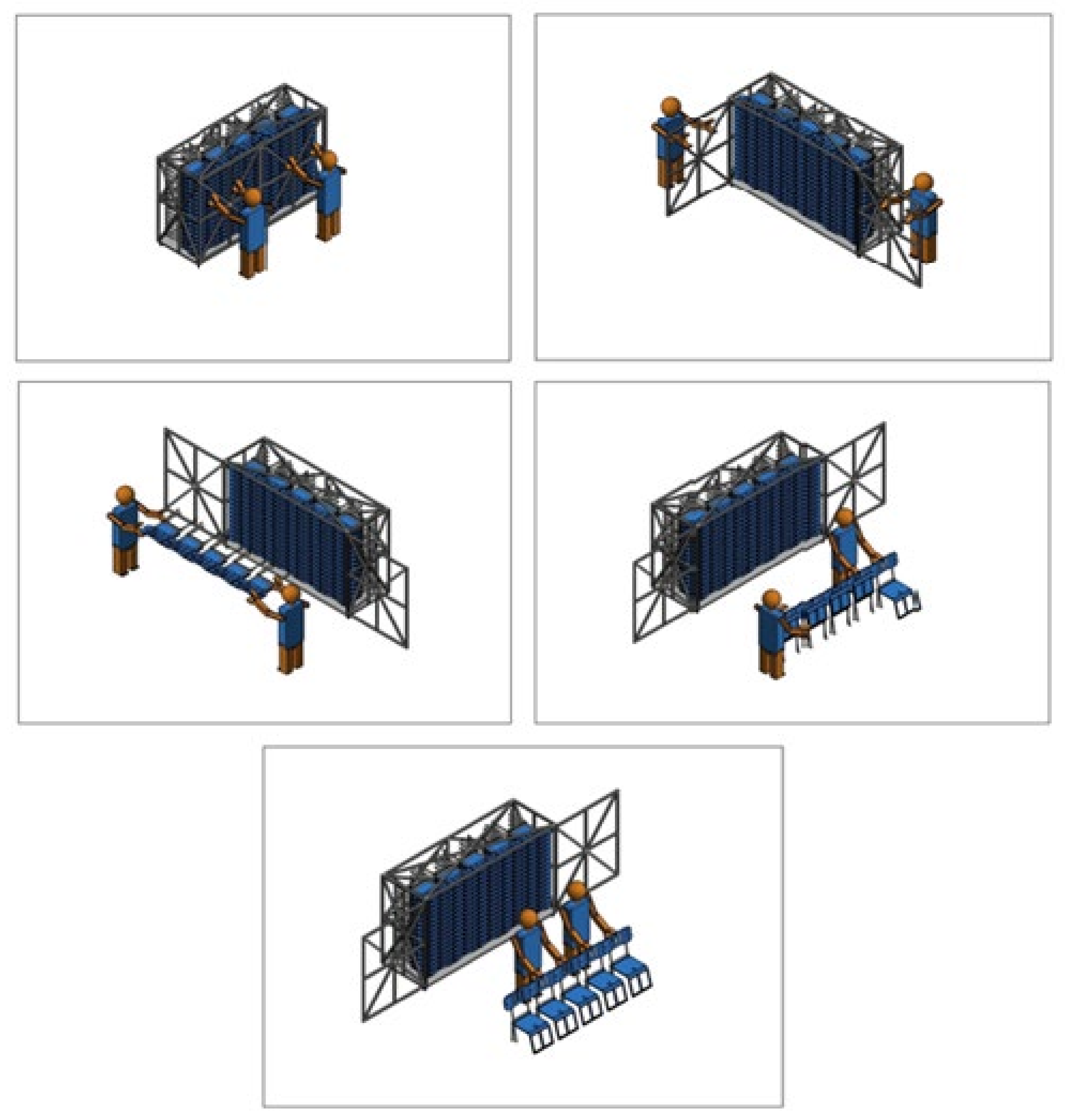
| Types of folding chairs | Folding chair with backrest and armrests.  | Armless folding chair with backrest. 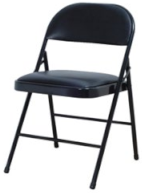 | Armless folding chair without backrest. 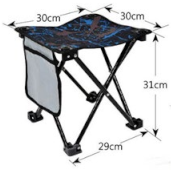 |
| Operation method. | Four feet to the center. | Open and close both hands. | The storage method of the four feet folded to the center. |
| Advantage. | 1. The rear is designed with a storage net. 2. Easy to carry. 3. Suitable for camping or outdoor use. | 1. Can be folded into a flat surface for easy storage. 2. Lightweight and quick to operate. 3. Suitable for placing in large quantities in various occasions. | 1. Small storage volume, easy to carry. 2. Suitable for camping or outdoor use. |
| Action | Question | Innovative Design Goals |
|---|---|---|
| Open | Generally, folding chairs cannot be unfolded quickly, and the safety of folding will also cause the possibility of pinching. | The TRIZ method is introduced into the innovative design of the folding chair for rapid unfolding. |
| Opening and closing | At present, most of the folding methods of folding chairs require bending over and merging with both hands to achieve the folding function of the folding chair. When arranging multiple chairs, it is possible to cause repetitive stress injuries and cause minor injuries to the waist and hands. | TRIZ introduces the innovative design of folding chairs for quick folding. |
| Storage action | At present, the general folding chairs are usually transported and arranged in the exhibition. Most of them require one chair or two chairs at a time. It is impossible to transport multiple chairs to the arrangement location. During the arrangement process, the chairs must be aligned one by one, which will require a lot of time and effort during the installation and process. | TRIZ introduces the innovative design of fast handling and exhibition arrangement functions. |
| Avoid Deterioration Parameters Want to Improve the Parameters | 2. Fixing Weight | 10. Strength | 27. Reliability |
|---|---|---|---|
| 9. Speed | 13.28 | 11.35 | |
| 15.12 | 27.28 | ||
| 25. Time loss | 10.25 | 10.37 | 10.30 |
| 26.05 | 35.05 | 4 | |
| 33. Easy to operate | 06.13 | 28.13 | 17.27 |
| 1.25 | 35 | 8.40 | |
| 35. Adaptability | 19.15 | 15.17 | 35.13 |
| 29.16 | 20 | 8.24 |
| Selected Invention Principles | Definition |
|---|---|
| No. 8 Balance Principle | Combine in a way that strikes a balance. |
| No. 10 Pre-action Principle | “Prepare in advance” for what will happen later. |
| No. 13 Reverse Operation Principle | “Invert” the various elements. |
| No. 15 Dynamic Principle | That is deformation. In addition to adding movable parts and additional adjustment functions, static functions are selected according to the field. |
| No. 25 Self-help Principle | It means “do it yourself” and its idealization is that all actions can be customized. |
| No. 35 Physical and chemical state change | Try to replace the existing material and reaction state with other parameters. |
| Avoid Deterioration Parameters Want to Improve the Parameters | 10. Strength | 27. Reliability | 35. Adaptability |
|---|---|---|---|
| 2. Fixing weight | 8.10 | 10.28 | 19.15 |
| 19.35 | 8.03 | 29 | |
| 9. Speed | 13.28 | 11.35 | 15.10 |
| 15.19 | 27.28 | 26 | |
| 25. Time loss | 10.37 | 10.30 | 35 |
| 35.05 | 4 | 28 | |
| 33. Easy to operate | 28.13 | 17.27 | 15.34 |
| 35 | 8.40 | 1.16 |
| Selected Invention Principles | Definition |
|---|---|
| No. 8 Balance Principle | Combine in a way that strikes a balance. |
| No. 10 Pre-action Principle | “Prepare in advance” for what will happen later. |
| No. 13 Reverse Operation Principle | “Invert” the various elements. |
| No. 15 Dynamic Principle | That is deformation. In addition to adding movable parts and additional adjustment functions, static functions are selected according to the field. |
| No. 35 Physical and chemical state change | Try to replace the existing material and reaction state with other parameters. |
| Avoid Deterioration Parameters Want to Improve the Parameters | 9. Speed | 25. Time Loss | 35. Adaptability |
|---|---|---|---|
| 2. Fixing weight | 10.20 | 19.15 | |
| 35.26 | 29 | ||
| 12. Shape | 35.15 | 14.10 | 1.15 |
| 34.18 | 34.17 | 29 | |
| 27. Reliability | 25.35 | 10.30 | 13.35 |
| 11.28 | 4 | 8.24 | |
| 33. Easy to operate | 18.13 | 4.28 | 15.34 |
| 34 | 10.34 | 1.16 |
| Selected Invention Principles | Definition |
|---|---|
| No. 1 Segmentation Principle | A principle that relies on segmentation to solve problems. |
| No. 10 Pre-action Principle | “Prepare in advance” for what will happen later. |
| No. 13 Reverse Operation Principle | “Invert” the various elements. |
| No. 15 Dynamic Principle | That is deformation. In addition to adding movable parts and additional adjustment functions, static functions are selected according to the field. |
| No. 35 Physical and chemical state change | Try to replace the existing material and reaction state with other parameters. |
| FBS | SAPPhIRE |
|---|---|
| For general folding chairs: Function: can be folded to reduce the space. Behavior: hands open so that the back and legs cross to form a chair and hands close to reduce the volume of storage. Structure: chair legs, back, seat. | Effect: foldable. State change: hands open so that the back of the chair and the legs cross to form a chair. Physical phenomenon: the use of the principle of cross triangular support. Organ: chair back, chair legs, chair seat. Input: open and close with the force of both hands. |
| For quick deployment of folding chairs. Function: can be folded to reduce the space, can be combined with multiple transport. Behavior: open with one hand so that the chair back and legs cross to form a chair, a single leg closed to reduce the volume of storage, a single chair can stand, multiple chairs can be combined and transported. Structure: back, legs, seat, pull ring, tread bar, fasteners, merging street. | Effect: foldable, can be combined with multiple sheets. State change: pull the pull ring to release the fastener to put down the chair legs and seat. Physical phenomenon: the principle of using four legs to support and the principle of merging multiple chairs. Organ: back, legs, seat, pull ring, pedal lever. Input: open with one hand and close with one foot. |
Publisher’s Note: MDPI stays neutral with regard to jurisdictional claims in published maps and institutional affiliations. |
© 2022 by the authors. Licensee MDPI, Basel, Switzerland. This article is an open access article distributed under the terms and conditions of the Creative Commons Attribution (CC BY) license (https://creativecommons.org/licenses/by/4.0/).
Share and Cite
Yao, K.-C.; Li, K.-Y.; Xu, J.-R.; Ho, W.-S.; Shen, Y.-H. Application of TRIZ Innovative System Method in Rapid Assembly of Folding Chairs. Sustainability 2022, 14, 15482. https://doi.org/10.3390/su142215482
Yao K-C, Li K-Y, Xu J-R, Ho W-S, Shen Y-H. Application of TRIZ Innovative System Method in Rapid Assembly of Folding Chairs. Sustainability. 2022; 14(22):15482. https://doi.org/10.3390/su142215482
Chicago/Turabian StyleYao, Kai-Chao, Kuo-Yi Li, Jing-Ran Xu, Wei-Sho Ho, and Yu-Hao Shen. 2022. "Application of TRIZ Innovative System Method in Rapid Assembly of Folding Chairs" Sustainability 14, no. 22: 15482. https://doi.org/10.3390/su142215482
APA StyleYao, K.-C., Li, K.-Y., Xu, J.-R., Ho, W.-S., & Shen, Y.-H. (2022). Application of TRIZ Innovative System Method in Rapid Assembly of Folding Chairs. Sustainability, 14(22), 15482. https://doi.org/10.3390/su142215482









